
CLICK HERE IF YOU HAVE NOT ALREADY OPTED IN!

CLICK HERE IF YOU HAVE NOT ALREADY OPTED IN!
MIDWEST
Ontario,
(905) 666-0778
jsimmons@idirect.com
WESTERN
Tim
West 10th Ave,
1Z1 604-910-1826
Fax: (604) 264-1397
E-mail: twshaddick@gmail.com
Kevin
619-1777
E-mail: lordkevincook@gmail.com
INTERNATIONAL
Spain
Tel: +34 96 640 4165 +34 96 640 4048
E-mail: murray.brett@abasol.net
PANEL INDUSTRY MOVES AHEAD
As I glanced through the pages of the six issues of Panel World in 2022, various news developments refreshed my memory, but underlying it all was just the fact that business for the most part was conducted as usual. That we were back to at least fairly normal hit home at the biennial PELICE in March in Atlanta, where the crowd was obviously enthusiastic to be back in the mainstream. Other events throughout the year proved it as well—from annual meetings to trade shows, and also because our editors were being welcomed back into the mills to work up articles. During the pandemic, we pieced together one article “virtually,” but it wasn’t nearly as good and detailed as doing it on site.
Here are some news items from 2022, in case you forgot:
—One Sky Forest Products said it would locate a new OSB plant in Prince Albert, Saskatchewan.
—A middle market private equity firm, One Equity Partners, purchased USNR.
—Several wood-based panel industry veterans came out against paperboard wall sheathing and its potential dangers during major storms.
—West Fraser purchased the idled OSB plant in Allendale, SC from Georgia-Pacific.
—GP announced plans to expand production capacity at its OSB plant in Alcolu, SC.
—Huber submitted a revised Environmental Assessment Worksheet to the city of Cohasset, Minn. regarding its proposed OSB plant.
—One Equity Partners equity firm purchased Oregon-based Rosboro.
—Tor Gustavsen, former managing director of Argos Solutions, died at 60.
—Eight keynote speakers, more than 50 presenters, 100 exhibitors and 450 participants made the eighth Panel & Engineered Lumber International Conference & Expo in Atlanta one of the best ever.
—Freres Lumber of Lyons, Ore. changed its name to Freres Engineered
Wood as part of its centennial celebration.
—Boise Cascade acquired Coastal Plywood and its plywood mills at Havana, Fla. and Chapman, Ala. for $512 million.
—A Quebec-based forestry family— the Cossette family—said it is investing $180 million to restart the OSB plant at Wawa, Ontario.
—Scotch Plywood started producing veneer at its new facility in Waynesboro, Miss., after a fire had destroyed the existing one in early 2021.
—Raute named Mika Saariaho as president and CEO.
—LP converted its mill in Houlton, Maine to siding production.
—Pacific Woodtech acquired LP’s EWP division and three LVL/I-joist manufacturing facilities for $210 million.
—George Weyerhaeuser Sr., former president and CEO of Weyerhaeuser and great-grandson of the founder, died at 95.
—Collins named Tom Insko as president & CEO, succeeding retiring Eric Schooler.
—SmartLam announced plans to build a glulam facility in Dothan, Ala. to supply the mass timber industry.
—Siempelkamp named a new CEO and CFO, Martin Scherrer and Martin Sieringhaus, respectively.
—Construction continued at Martco’s new OSB plant in Corrigan, Texas, which will be the company’s second OSB mill at that site. PW
RICH DONNELL
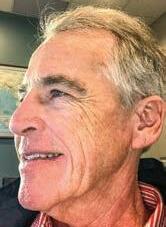
EDITOR-IN-CHIEF
Ph: 334-834-1170
Fax: 334-834-4525 e-mail: rich@hattonbrown.com
PanelWorld • NOVEMBER 2022 • 3 STOCK TAKING ■ ■ ■ ■ ■ Hatton-Brown Publishers, Inc. Street Address: 225 Hanrick Street Montgomery, AL 36104-3317 Mailing Address: P.O. Box 2268 Montgomery, AL 36102-2268 Telephone: 334-834-1170 Fax 334-834-4525 ■ ■ ■ ■ ■ Publisher David H. Ramsey Chief Operating Officer Dianne C. Sullivan ■ ■ ■ ■ ■ Editor-In-Chief Rich Donnell Senior Editor Dan Shell Senior Editor David Abbott Senior Editor Jessica Johnson Contributing Editor Fred Kurpiel ■ ■ ■ ■ ■ Publisher/Editor Emeritus David (DK) Knight ■ ■ ■ ■ ■ Production Manager/Art Director Cindy Segrest Ad Production Coordinator Patti Campbell Circulation Director Rhonda Thomas Online Content & Marketing Manager Jacqlyn Kirkland ■ ■ ■ ■ ■ Advertising Sales Manager David H. Ramsey • (334) 834-1170 ■ ■ ■ ■ ■ ADVERTISING SALES REPRESENTATIVES SOUTHERN U.S. Kathy Sternenberg • (251) 928-4962 ksternenberg@bellsouth.net Classified Advertising Bridget DeVane • (334) 669-7837 • 1-800-669-5613 bdevane7@hotmail.com
USA, EASTERN CANADA John Simmons Mar-Tech Communications 32 Foster Cres. Whitby,
Canada L1R 1W1 (905) 666-0258 Fax:
E-mail:
USA, WESTERN CANADA
Shaddick 4056
Vancouver BC Canada V6L
Cook (604)
Murray Brett 58 Aldea de las Cuevas Buzon 60 03759 Benidoleig (Alicante),
CLICK HERE IF YOU HAVE NOT ALREADY OPTED IN!
plants and allied export-import businesses throughout the world. All non-qualified U.S. subscriptions are $50 annually; $60 in Canada; $95 (Airmail) in all other countries (U.S. funds). Single copies, $5 each; special issues, $20 (U.S. funds). Subscription Inquiries TOLL-FREE 800-669-5613; Fax 888-611-4525. Go to www.panelworldmag.com and click on the subscribe button to subscribe or renew via the web. All advertisements for Panel World magazine are accepted and published by Plywood & Panel World, Inc. with the understanding that the advertiser and/or advertising agency are authorized to publish the entire contents and subject matter thereof. The advertiser and/or advertising agency will defend, indemnify and hold Plywood & Panel World, Inc. harmless from and against any loss, expenses, or other liability resulting from any claims or lawsuits for libel violations or right of privacy or publicity, plagiarism, copyright or trademark infringement and any other claims or lawsuits that may arise out of publication of such advertisement. Plywood & Panel World, Inc. neither endorses nor makes any representation or guarantee as to the quality of goods and services advertised in Panel World. Hatton-Brown Publishers, Inc. reserves the right to reject any advertisement which it deems inappropriate. Copyright ® 2022. All rights reserved. Reproduction in whole or in part without written permission is prohibited. Printed in USA.

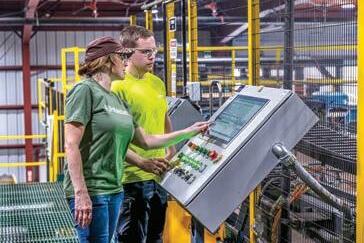
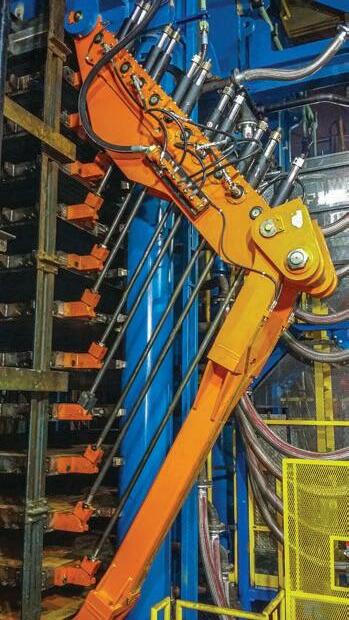
 Member, Verified Audit Circulation Managed By Hatton-Brown Publishers, Inc.
Member, Verified Audit Circulation Managed By Hatton-Brown Publishers, Inc.

4 • NOVEMBER 2022 • PanelWorld Plywood & Panel in 1960—Our 517th consecutive issue) VOLUME 63 NO. 6 Visit our web site: www.panelworldmag.com NOVEMBER 2022 PRESSES Latest Technologies being challenged by the new demands of the upcoming labor force; that is if even the labor is available to begin with. This article examines six approaches to more effective staffing. Story begins on PAGE 12. (Jessica Johnson photo) 3020 POTLATCHDELTIC Layup Project UPDATE Good For Tony V. 8 EDITORIAL INDEX Stories In 2022 32 PELICE IV Final Coverage 34 TP&EE Good Show 40 JELD-WEN New Door Line 42 EVENTS Into 2023 62 AD LINK Our Advertisers 62 PROJECTS Lots Going On 44 SUPPLY LINES S’Kamp Leadership 56 GEO DIRECTORY Veneer/Panel Suppliers 59 PANELWORKS Classified Advertising Panel World (ISSN 1048-826X) is published bimonthly by Plywood & Panel World, Inc., P.O. Box 2268, Montgomery, AL 36102-2268 (334) 834-1170, Fax (334) 834-4525. Subscription Information— PW is sent free to owners, operators, managers, purchasing agents, supervisors and foremen at veneer operations, plywood plants, composite products plants, structural and decorative panel mills, engineered wood products
CLICK HERE IF YOU HAVE NOT ALREADY OPTED IN!

CLICK HERE IF YOU HAVE NOT ALREADY OPTED IN!

CLICK HERE IF YOU HAVE NOT ALREADY OPTED IN!

CLICK HERE IF YOU HAVE NOT ALREADY OPTED IN!
TONY VUKSICH
APA—The Engineered Wood Assn. presented Tony Vuksich the 2022 Bronson J. Lewis award during the APA Annual Meeting held October 15-18 at the J.W. Marriott Turnberry Resort in Aventura, Fla. The award is named in honor of the late Bronson Lewis, who served for 24 years as secretary and then executive vice president of the association. The award recognizes indi-
viduals for their leadership and outstanding contributions to the engineered wood industry.
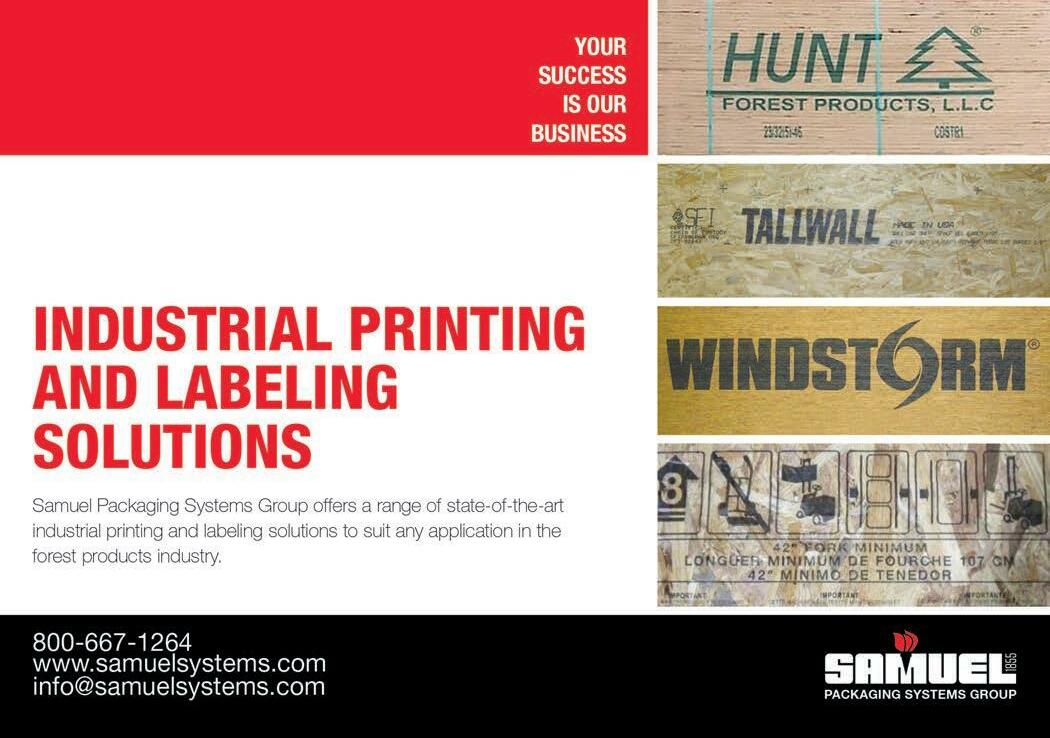
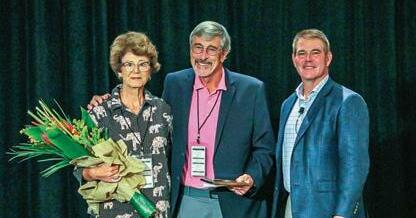
Vuksich recently announced his retirement after serving the engineered wood industry for 50 years. He began his life-long career with Willamette Valley Co. in 1972 in sales. He became a branch manager in 1976, a regional manager in 1980, vice president of the northwest in 1996 and global wood vice president in 2010. He also supported the establishment of Willamette Valley Co. facilities in Chile and the Netherlands.
In addition to his work with Willamette Valley Co., his contributions to the engineered wood industry include a 20-year term serving on the EWTA (Engineered Wood Technology Assn.) Advisory Committee where he worked on funding special projects for APA and promoting the EWTA Info Fair and membership. He has served as an active member of the Wood Based Composite Center for the last 12 years. He has organized APA’s Mike St. John Golf Tournament for the past 35 years.
Vuksich will continue to contribute to the industry maintaining the golf tournament operations.
A standing ovation greeted the announcement by APA Board Chairman Roy O Martin III. Accepting the award, at times his voice breaking with emotion, Vuksich read the names of the previous recipients of the award and commented, “I don’t belong on this list, but here I am.” He thanked his wife, Anita, for her support during all his travels, and he thanked the engineered wood industry community for providing him lifelong friendships and experiences.
APA President Mark Tibbetts added, “On behalf of the members and APA staff, we wish Tony only the best in his retirement.”
SMARTLAM PLANS
GLULAM FACILITY
SmartLam North America, reportedly the largest manufacturer in North America of cross-laminated timber (CLT),
UPDATE APA HONORS
Tony Vuksich, center, flanked by his wife, Anita, receives the Bronson J. Lewis Award from APA Board Chairman Roy O. Martin III.
8 • NOVEMBER 2022 • PanelWorld CLICK HERE IF YOU HAVE NOT ALREADY OPTED IN!

CLICK HERE IF YOU HAVE NOT ALREADY OPTED IN!
announced it will build a $50 million glulam manufacturing facility in Dothan, Ala.
The new SmartLam facility, to be built adjacent SmartLam’s existing CLT facility in a 144,000 sq. ft. structure, will manufacture 84MMBF annually of glulam beams and columns that are required to serve the mass timber market. SmartLam has chosen to partner with Ledinek to build a turnkey, state-of-theart glulam facility. The new glulam facility is expected to be 100% operational in October of 2024.
SmartLam North America CEO
Derek Ratchford states, “We are pleased to announce the new stateof-the-art custom glulam manufacturing plant which will be the largest custom glulam plant in North America,” adding that Dothan is strategically located in Alabama to serve the Southeast, the fastest growing mass timber market in the United States, and that SmartLam North America has 1.5 billion BF of available southern pine lumber annually between its four Southern sawmill shareholders.
SmartLam North America will also spend an additional $24 million to fully automate the existing Dothan and Columbia Falls, Mont. CLT facilities. This additional investment will allow each facility to produce 2 million cubic feet annually.
Ratchford adds, “The new glulam plant will be automated allowing SmartLam to significantly increase production and simultaneously deliver multiple mass timber projects. With the CLT automation upgrades and the new glulam
addition, SmartLam will become the largest mass timber (CLT/glulam) producer in North America.”
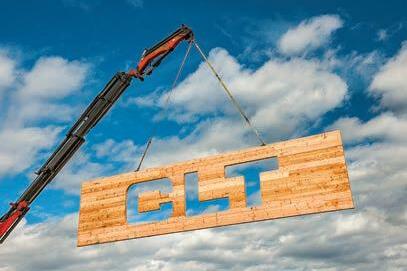
PEAK ANNOUNCES
SYP PELLET MILL
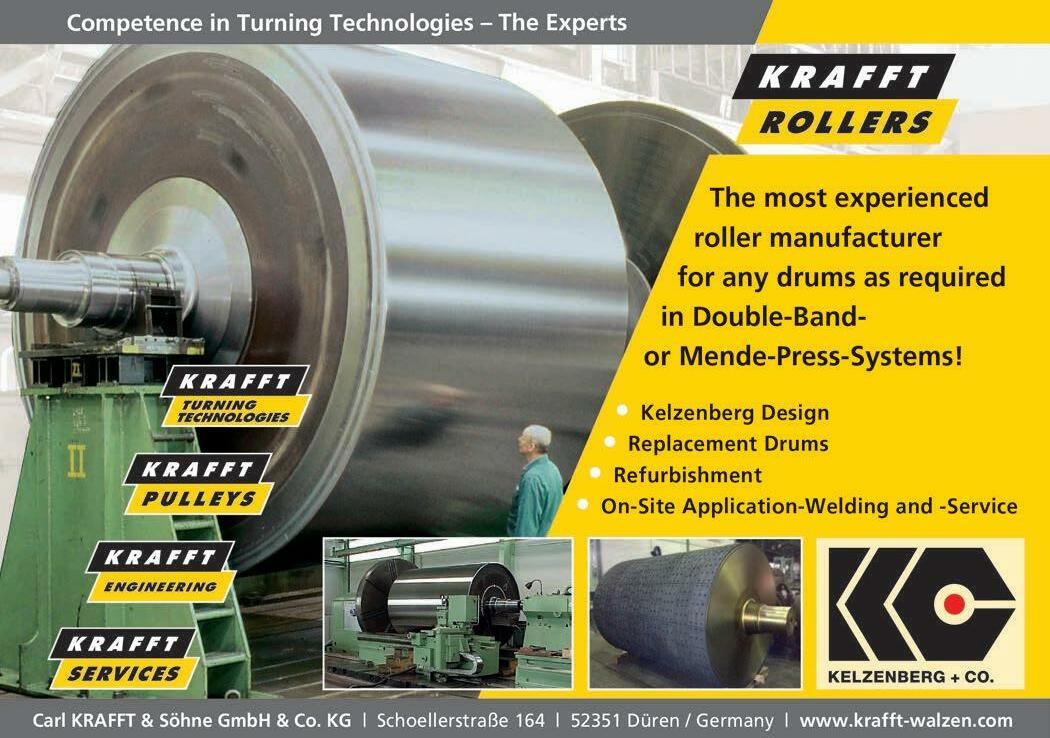
Vancouver, Canada-based Peak Renewables plans to build a 180,000 metric tons per year wood pellet mill in Dothan, Ala. The $30 million project will utilize residuals from Rex Lumber sawmills in the area.
Construction on the facility is expected to be completed by mid-2023. Peak is building the plant adjacent the SmartLam cross-laminated timber plant and upcoming glulam facility in Dothan.
Peak and SmartLam have some common ownership, including longtime sawmill construction and equipment supplier Brian Fehr. Scott Bax, formerly COO with Pinnacle Renewable Energy, is the CEO of Peak, which is also a partner in a proposed OSB facility in Prince Albert, Saskatchewan called One Sky Forest Products.
UPDATE
10 • NOVEMBER 2022 • PanelWorld CLICK HERE IF YOU HAVE NOT ALREADY OPTED IN!
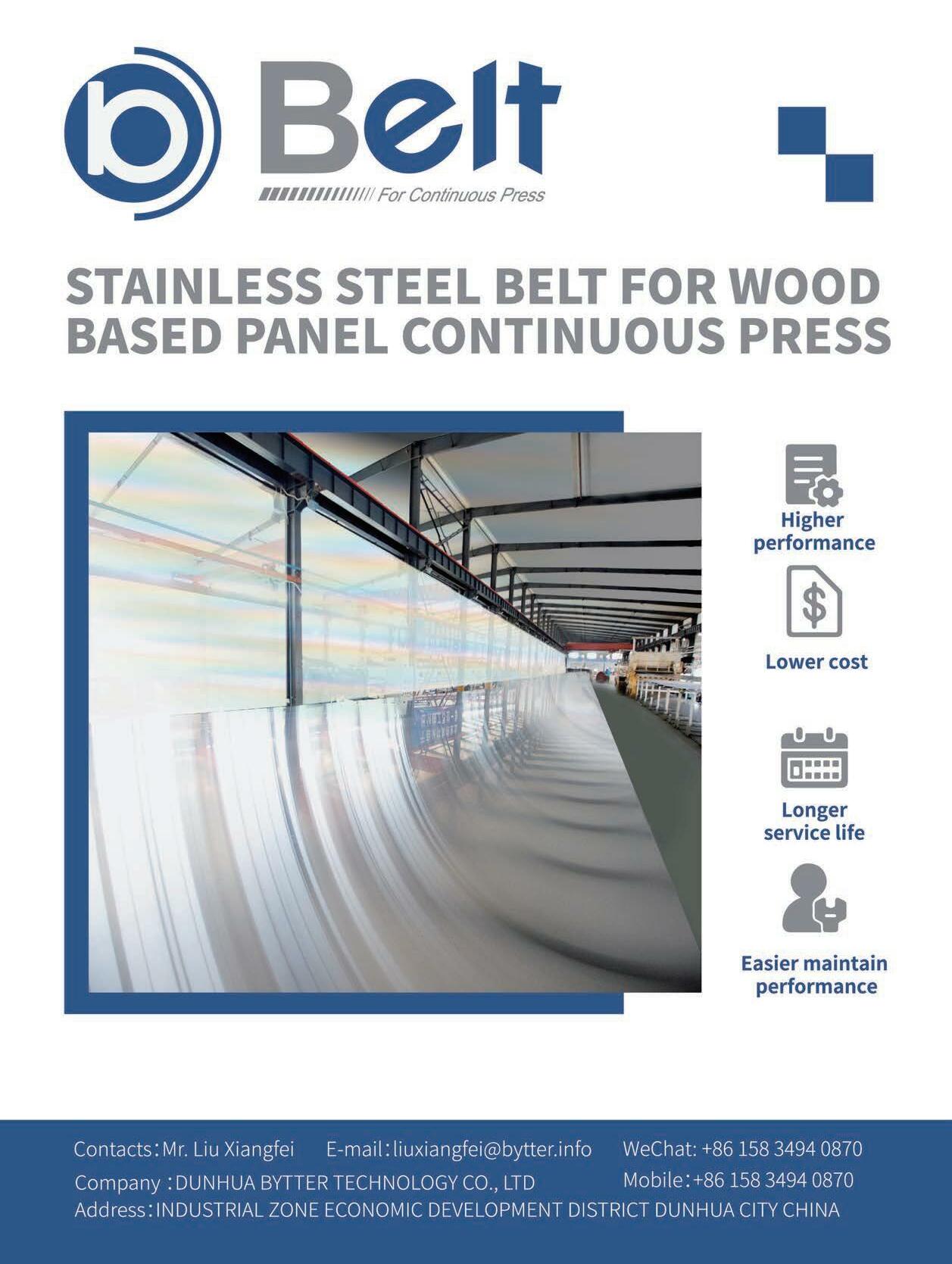
CLICK HERE IF YOU HAVE NOT ALREADY OPTED IN!
BY RICHARD F. BALDWIN, RICHARD W. BALDWIN
During a post-pandemic series of site visits and phone interviews, plywood and veneer manufacturing operators articulated the common concern of “We don’t have enough people to run the mill on a full schedule.” Several expressed surprise and disappointment because experienced employees failed to return, and few job seekers applied. Owners often increased wages and added monetary and non-monetary incentives, but still did not attract enough workers. One concluded, “You know, this younger generation is just different.”
This article, drawing upon practical mill examples as well as academic research, suggests six action steps to mitigate and even resolve the current mill staffing challenges. Each individual step will improve personnel recruiting and retention and, if implemented together, the positive impact will be magnified. While these time-tested techniques are not exhaustive or “one size fits all,” hopefully these ideas stimulate creative thinking that directly applies to the local conditions of your operation.
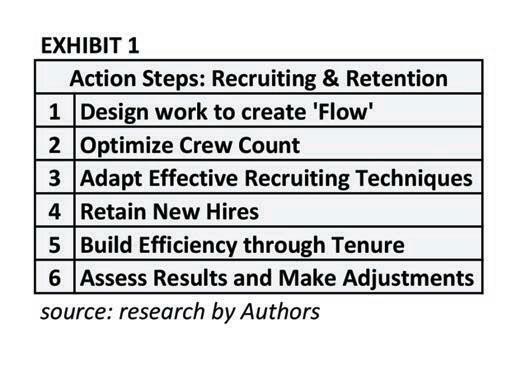
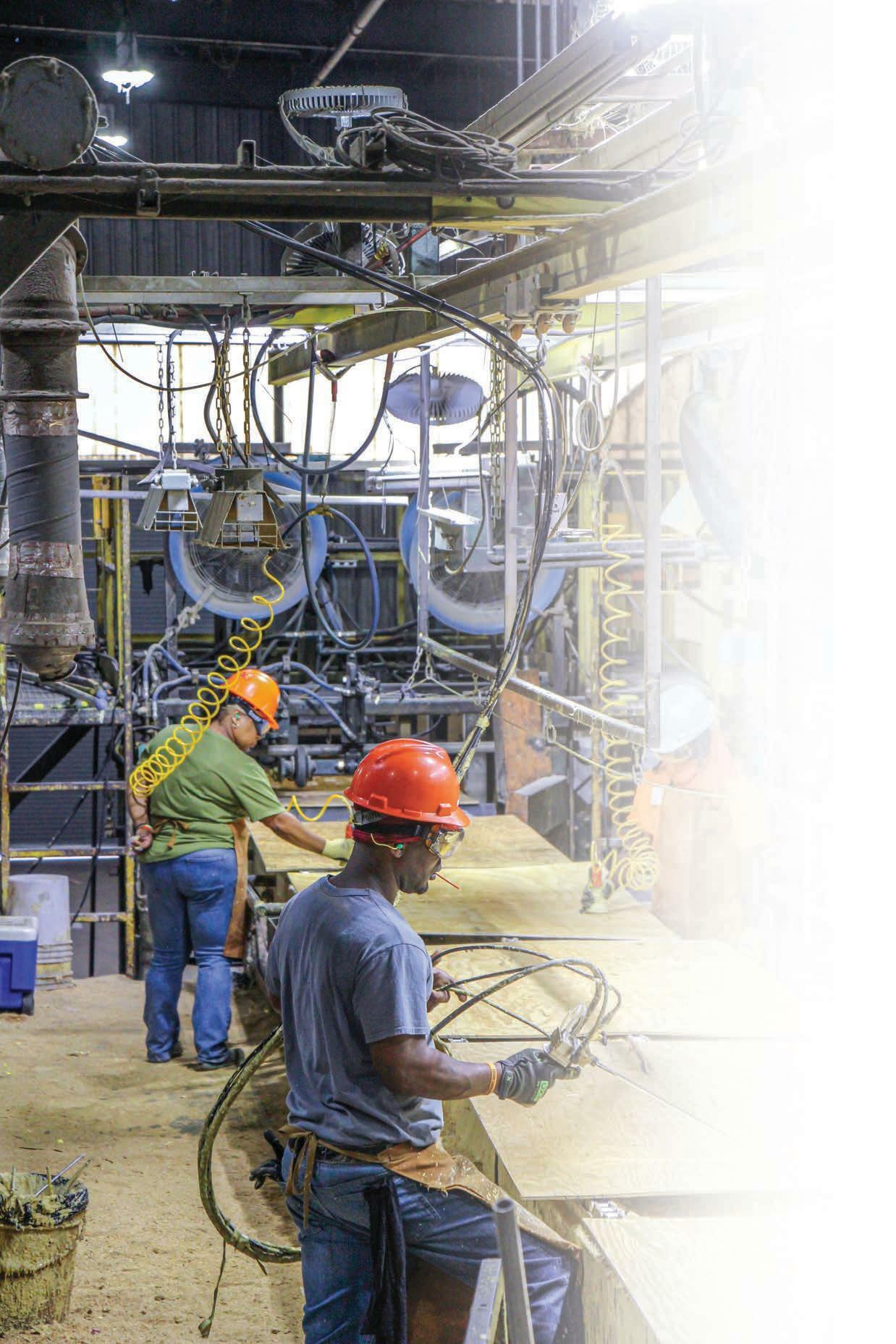
HISTORICAL TAKE
The secular downsizing of the plywood industry since the 1980s, amplified by the 2008 Great Recession and the 2020 COVID pandemic, has resulted in perpetual challenges for mill operators. Barring the unprecedentedly profitable period from summer 2020 to summer 2022, mill operators normally struggle to earn more than the cost of capital.
SIX ACTION STEPS FOR VENEER-BASED PRODUCERS TO IMPROVE RECRUITING & RETENTION
“Six-way-staffing” can benefit labor-intensive operations that experienced pandemic and post-pandemic personnel challenges.
CLICK HERE IF YOU HAVE NOT ALREADY OPTED IN!
These long-term plywood industry trends continue to shake the foundations of veneer-based businesses. Many veterans, often the most able, productive and experienced, retired or otherwise exited the industry in recent years. Unfortunately, the product knowledge, efficiency, and supervisory skills of those veterans have proven difficult to replicate.
Offshored manufacturing sectors have returned to North America in recent years, and the pandemic amplified this tendency. Companies have decided that manufacturing close to home makes sense due to ocean shipping obstacles, trade tensions with rival countries, and random pandemic factory shutdowns. Jay Timmons, CEO of the National Assn. of Manufacturers, stated in October 2022, “For every 100 job openings in the [manufacturing] sector we only have 60 people who are looking.” Besides competing with other wood producers for a workforce, veneerbased manufacturers compete with all employers.
Sizable efforts are needed to maintain business stability during the normal lean times by recruiting and retaining a new generation of skilled workers. However, generational shifts in norms and values mean that hiring and retention techniques that functioned well a few decades ago may not prove effective today.
1. DESIGN WORK TO CREATE ‘FLOW’
Chances are that you had to make tough human resources decisions to survive the first months of the pandemic. Now, a key task is to mend and improve the damaged people relationships. Begin by ascertaining that your workplace meets the needs of both mill veterans and new hires.
This self-assessment is important because younger people often have distinctly different values, expectations and interests than their parents and grandparents. Needed workplace adjustments reflect that the meaning of work and job expecta-
tions have evolved since you entered the workforce.
Jobs traditionally were essential for monetary income, a sense of self-worth, and respect in the community. As shown by declining labor participation, now individuals can figure out how to get by without a job. For example, the conservative CATO Institute reports that unemployment benefits and other government assistance in some states provide income greater than entry-level jobs (even before Pandemic Economic Impact Payments and Enhanced Unemployment Benefits). In addition, societal trends such as postponing marriage and children, living with parents, and extended school stays can effectively delay the economic need for a job.
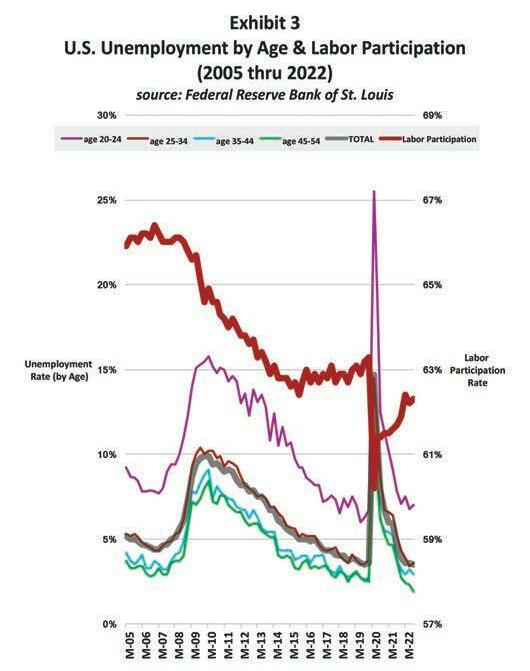

Plywood and veneer producers lag lumber and OSB in automating tedious job functions. Pulling on the green chain, feeding veneer dryers, laying plywood core, and other monotonous plywood manufacturing steps have decreasing appeal to prospective workers.
The Hungarian-American social scientist Mihaly Csikszentmihalyi argued that the best work is characterized as a pleasant experience in which engaged and involved participants lose track of time. He designated the resulting experience as “Flow.” (see Csikszentmihalyi, Mihaly. Flow: The Psychology of Optimal Experience. New York, HarperCollins, 1990.)
One West Coast mill has found a straightforward answer to engage its workforce. The author noted an unusual interest in the repetitive work during a mill walk-through. The manager reported very little turnover after implementing a bonus system that pays very well for extraordinary operating performance and profitability. Not surprisingly, the production crew proactively creates innovations that make job functions and material usage more efficient.
A key function of management is to facilitate “Flow” by providing just-right support for the crew. When asked, a mill
PanelWorld • NOVEMBER 2022 • 13 CLICK HERE IF YOU HAVE NOT ALREADY OPTED IN!
owner characterized current leadership practices as “Servant Leadership.” He said, “Collectively, they (the crew) will always have an answer.” Hard data supports this owner’s contention; for example, last year’s green end production record has become this year’s operating norm.
In the 1960s, a plant manager for whom he had previously worked hired the author over the phone to start up graveyard shift at a failing plywood mill. Sight unseen, the young supervisor hired an experienced crew from western Oregon and everybody relocated their families to rural Idaho. After discovering that the mill was woefully obsolete but with failure not an option, supervisor and crew jointly developed a plan to make the best out of what they had. Necessity caused the author to figure out that success occurs only when the manager’s role becomes removing barriers that prevent crew members from reaching their individual and shared goals. Quantity and quality of production soon exceeded other shifts, and the mill became profitable enough for the corporation to justify a greenfield replacement facility. (see Baldwin, Richard F. Creating a HighPerformance Operation: Reflections on Leadership and Change. Allen TX, Oak Creek Investments, 2022.)
“Flow-like” culture is best created by an involved and participative workplace. Achieving Flow requires clear goals jointly created by participants with a vested interest. Goal achievement requires timely and accurate re-
porting of important process, quality and safety performance indicators, with each crew member able to access the data. Improvement is based on the premise that engaged and knowledgeable workers have the personal incentives and skills to develop better practices, and the purpose of leaders is to facilitate progress.
2. OPTIMIZE CREW COUNT
Labor usually is a mill’s second largest operating cost after wood fiber. During the pandemic, unplanned absences often caused a scramble for healthy employees able to work overtime. Workers in unfamiliar jobs adversely affected productivity (as measured by production per man hour). Fortunately for most, record product prices more than offset higher unit costs from lower productivity.
There is a natural desire to return to “normal” by setting crew count at the pre-pandemic level. However, the pandemic necessity to reduce manhours can lead to a permanently slimmer crew count. The following are examples of problems solved by mill operators.
At a plywood mill in the Southeast, a new manager was hired to “fix” a mill that had consistently lost money for several years. The sales volume and product mix did not justify 140 hourly jobs. The manager initially attempted to become profitable by increasing production volume. However, additional volume did not improve sales return or lower the mill’s fixed costs.
After the failure of the increased volume tactic, in a second attempt the manager developed a product mix that required fewer employees. Market forecasts and financial models revealed that the mill could become profitable with a crew count of no more of 115. The challenge then became working smarter instead of working harder.
Understanding answers to the following questions contributes to just-right staffing levels:
l How can we eliminate activities that don’t add value?
l How can we rearrange processes to make work flows more efficient?
l How can we combine tasks to eliminate labor inputs?
l How can we reinvent the process to better use labor?
Informal usage of the Group Timing Technique (GTT) became the basis for obtaining process data to answer those questions. Trained industrial engineers
can gather the data, or it’s easily taught to production leaders. (see Zandin, Kjell. Maynard’s Industrial Engineering Handbook, 5th Ed. – Chapter 17 New York, McGraw Hill, 2001).
At random times, observers recorded production activities. The four questions helped managers, with production crew input, to analyze the data and identify potential manning efficiencies. Implementation and acceptance came by show and tell education on the mill floor. Hiring ceased until headcount naturally declined by 25 workers.
In another recent example, a Northwest plywood mill suspended pulling random-width and fishtail veneer off the green chain due to the labor shortage. Full and half sheets replaced randomwidth and fishtail veneer as plywood crossbanding. However, management did not quickly redeploy the core layer positions that had become superfluous. Reassigning excess core layers to other positions would have reduced the crewing shortage, at least until the green end returned to pre-pandemic operations.

3. ADAPT EFFECTIVE RECRUITING TECHNIQUES
The author’s early introduction to hiring consisted of little more than phoning small-town acquaintances or meeting applicants that wandered in off the street. Selected new hires were then instructed to complete employment formalities the next morning. The introduction to the art and science of making plywood consisted of assigning the new hire, under the oversight of a coworker, to a less desirable position such as feeding random-width veneer on a veneer dryer or offbearing on the green chain.
Government employment regulations now abound and Human Resources professionals oversee the hiring process. Increased automation requires better training, and attracting qualified applications is a challenge. The following practices will help build an applicant flow:
l Reputation. A good community reputation as a fair and safe employer is essential. The author has witnessed poor safety results become a major barrier to recruiting.
l Perception of Supervision. Management’s leadership style has great importance. For example, the previously mentioned Servant Leader concept creates recognition as a good place to work.
l Work Schedules. Prospective employees want to feel comfortable that predictable hours and tasks will allow
14 • NOVEMBER 2022 • PanelWorld CLICK HERE IF YOU HAVE NOT ALREADY OPTED IN!

CLICK HERE IF YOU HAVE NOT ALREADY OPTED IN!
them to maintain a balanced life. The idea that a job will dominate earning years no longer is the cultural norm.
l Compensation. Compensation is more than base wages. At a minimum, the most effective incentive plans provide bonuses based on achievable goals (with the bonuses awarded short-term).
Ideal recruiters are community influencers. But what is a community influencer? Paul “Bear” Bryant, the legendary Alabama football coach, knew how to build a championship team.
Bryant recounts assigning a friend to order coffee each day at a diner where influential Alabama football supporters regularly met. Before the era of bothersome NCAA rules, this informal network became an important source of funds and player referrals. (see Bryant, Paul. Bear: the Hard Life and Good Times of Alabama’s Coach . Boston, Little Brown, 1974.)
Applying Bear Bryant’s recruitment philosophy to veneer-based manufacturing, local influencers such as ministers, educators, and business people are a useful source of quality referrals. Satisfying current employees is another “stellar” way to advertise to candidates. And remember, recruiting never ceases because of likely future turnover.
4. RETAIN NEW HIRES
With more available jobs than applicants, meeting the expectations of today’s job seeker is essential to retaining new hires. Jobs must meet the needs of employee as well as employer. During the site visits and phone interviews, mill operators recognized that the need

for employee/employer balance likely will become even more important.
Technology usage in plywood production was increasingly obvious not only during these recent visits to Pacific Northwest and Southeastern mills, but also during pre-pandemic site visits to Asian and South American producers. Skilled employees have never been more needed. Taking advantage of younger people’s comfort with technology requires the employer to accept that employees increasingly demand interesting jobs.

The so-called Millennial generation now comprises the majority of potential new hires. Generation Z is approaching working age. Technology has steadily advanced in recent decades, and to the author the computer savvy of his children and grandchildren is astounding.
As previously mentioned, a core staffing assumption no longer can be that new employees are economically anchored to a paycheck. The initial judgment that the job experience will satisfy the new employee’s non-financial needs often occurs within a few days. Therefore, quickly delivering the expected “Flow-like” work experience is key for retention. Besides making capital invest-
16 • NOVEMBER 2022 • PanelWorld CLICK HERE IF YOU HAVE NOT ALREADY OPTED IN!
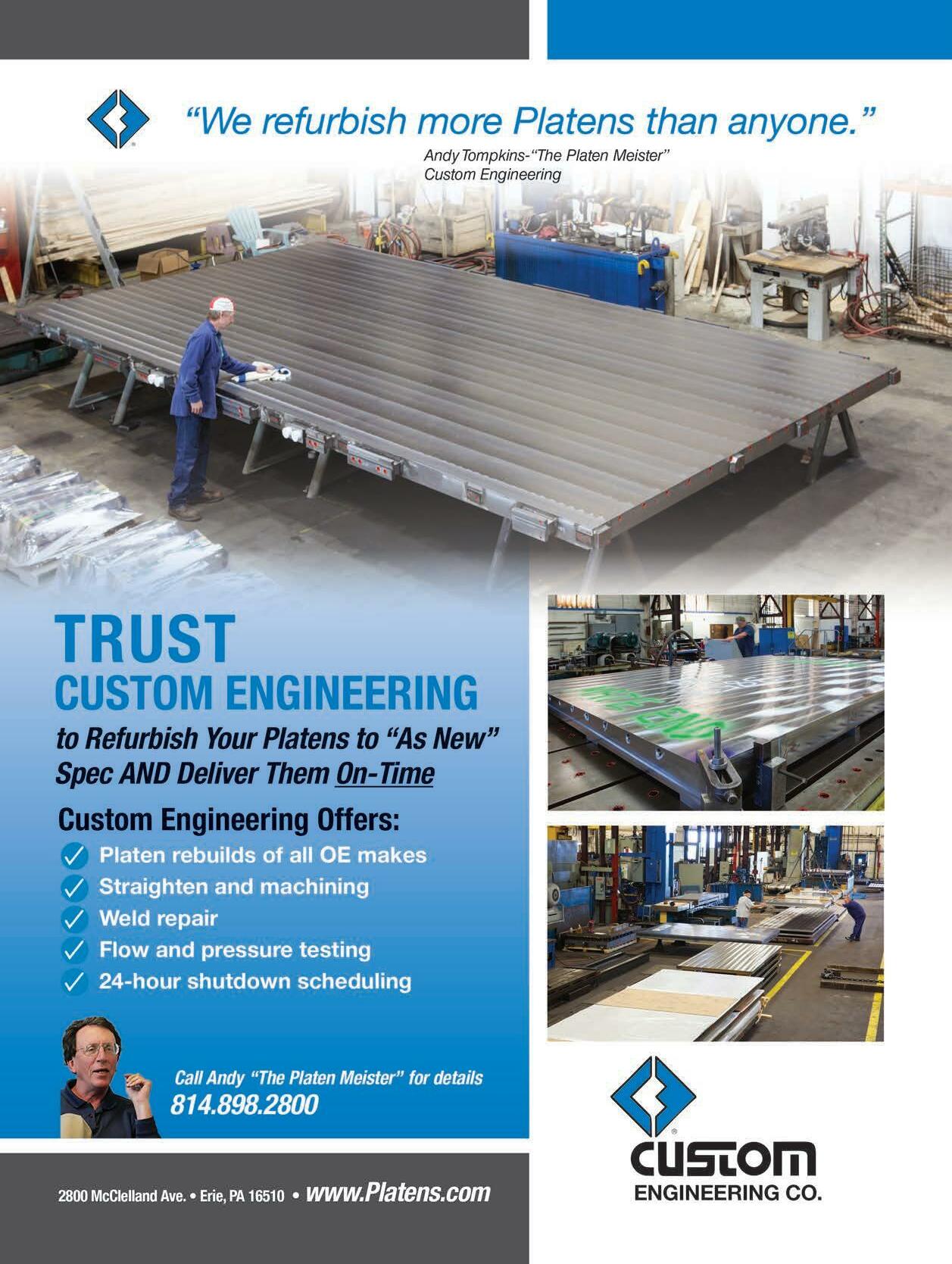
CLICK HERE IF YOU HAVE NOT ALREADY OPTED IN!
ments that automate plywood production as soon as financially sensible, it’s worth emphasizing that wood construction materials are a net benefit for the environment and your workplace welcomes and treats with dignity anybody capable of doing the assigned job.

5. BUILD EFFICIENCY THROUGH TENURE

Currently led by the grandsons of the founder, Freres Engineered Wood of Lyons, Ore. has evolved from an oldgrowth sawmill into a manufacturer of
the veneer-based engineered wood products of plywood and Mass Plywood. The author attended the Centennial celebration of Freres Engineered Wood during summer 2022. Besides commemorating the Century since T.G. Freres established the company, the ceremony also recognized 100 years of invaluable support from employees and the community.
Long-term employees effectively become partners. A company biography (Peterson, James. Santiam Song. Lyons OR, Freres Lumber Co., 2019) summarizes this philosophy: “It should surprise no one that we see our longest serving employees as family members.” The book lists 72 employees (out of total headcount of about 450) with tenure of at least 20 years. The author recently ran into a familiar face, Norm Persons, an active employee since 1969!
Freres’ cultural norm, which the author has seen in other successful producers, provides a pattern for achieving long employee tenure. Essentially the company develops relationships of trust with employees and the wider community. Key non-monetary employer traits that contribute to employee satisfaction and long tenure include:
18 • NOVEMBER 2022 • PanelWorld ➤ 58 CLICK HERE IF YOU HAVE NOT ALREADY OPTED IN!

CLICK HERE IF YOU HAVE NOT ALREADY OPTED IN!
EDITOR’S NOTE: The following companies submitted these editorial profiles and images to complement their advertisements placed elsewhere in this issue. Please refer to those advertisements for web site and contact information. All statements and claims are attributable to the companies.
DIEFFENBACHER
Environmental regulations are tightening, and the cost of CO2 emissions is increasing. The good news: The Dieffenbacher CPS+ continuous press system at the heart of your plant helps you balance economic and sustainability goals to build a better future for your business and the environment.
Dieffenbacher’s Press Emission Control System is just one tool to help you achieve that balance. It protects the environment by cleaning exhaust gases from the press through a washing process. Dust and condensable fractions of exhaust gases are bound to fine water droplets. These solid and liquid parts are separated in the unique Inline Scrubber. In addition, pre-absorber units are available to reduce VOC emissions (volatile organic compounds), particularly formaldehyde.
Another option is to re-use heat from the press exhaust air elsewhere in the production process. When the press exhaust air is cleaned by a wet air cleaning system, for example, the Inline Scrubber in the Press Emission Control System, the process water from the wet air cleaning system cools down. The result is more effective air cleaning, as cold water binds emissions better. The recovered low-calorific heat from the process water can then be used, for example, to preheat the hall air inside the production building to save heating energy and costs. It can also be used to preheat the glue. This not only saves energy, but the resulting lower viscosity glue enables a more precise glue spray pattern. More consistent operations, meanwhile, produce less excess glue.
These are just two of many ideas to reduce energy costs and emissions and increase profits by re-using press exhaust air.
HYMMEN
The grande dame of surface finishing: In what is already the fifth decade since its market launch, Hymmen’s double belt press technology is still in demand.
“Hymmen double belt presses are used in 80% of laminate flooring production worldwide,” was already communicated a few years after the market launch of double belt presses at the Ligna 1985. This technology is still of outstanding importance in the manufacture of flooring and other product—in and outside the wood-based materials industry.

Flooring, technical laminates, building materials, PVC flooring, conveyor belts or innovative composite materials such as the Curve material—the fields of application of double belt press technology for end products within and outside the wood-based materials industry are diverse. Over the decades, however, the continuous production of decorative laminates has established itself as the standard application, with these HPL or CPL laminates being used in a variety of ways for furniture, worktops and windowsills, doors, edge bandings or other types of resistant decorative surfaces.
When Dr. René Pankoke took over the management of the family business from his father in 2002, he continued the previous success story of double belt press technology. In the spirit of an overall entrepreneurial approach, he succeeded in designing not only machines but entire plants that cover several, if not all, process steps in the customer’s manufacturing process with Hymmen machines.

For example, double belt press technology has been linked to digital printing: boards digitally printed directly with the JUPITER Digital Printing Line can then be provided with synchronous pores using the LLT process (Classen). Alternatively, the decorative paper produced with the JUPITER or SATURN Digital Printing Line can be easily pressed into CPL. Another form of linking the double belt press to other Hymmen product groups is the finishing of CPL using the Calender Coating Inert (CCI) process. Matt anti-fingerprint surfaces can be produced in this way, as can high-gloss surfaces.
What started out as a substitute technology for other pressing processes with the advantage of economic efficiency for large capacities, developed over time into a process that offers a unique selling point with regard to the integration of other upstream or downstream

20 • NOVEMBER 2022 • PanelWorld PRESSES
Recovered heat from the press exhaust air preheats the glue.
HPL double belt press for high-gloss laminates at Egger
CLICK HERE IF YOU HAVE NOT ALREADY OPTED IN!

CLICK HERE IF YOU HAVE NOT ALREADY OPTED IN!
process steps in the customer’s overall production process. The fact that the technology is still as much in demand today as it was in its youth is shown by the latest orders received by Hymmen: There are currently six double belt press line projects in the order backlog.
IPCO
IPCO is world-leading supplier of premium quality steel press belts used in the production of wood-based panel products including particleboard, MDF, OSB and LVL (Laminated Veneer Lumber).
The company has played a central role in the evolution of the WBP industry, developing the belt materials and engineering standards that help to deliver premium quality board materials. One such area is thin fiberboard, a product that requires the use of thick press belts manufactured to extremely fine tolerances.

Thin fiberboard is widely used in furniture where its fine fibered surface supports a wide range of coatings including laminate, paint, foil and veneer. It is also in honeycomb sandwich panels and as a carrier board for laminate flooring.
All IPCO press belts undergo strict testing as part of the grinding process but belts for this application require even finer tolerances and the company has developed an all-new linear belt grinding tool to increase the thickness quality of welded joints.
A major challenge in this sector is the high production speeds involved—often as high as 2 500 mm/sec—which create stresses on the belt that can result in edge deformation. Glue lumps are another threat; when running thin products, typically under 4 mm but some as thin as 1.5 mm, the result can be dents or even holes in the belt.
Risk can be minimized through appropriate quality management procedures and IPCO’s service team is available to provide support in the form of preventative maintenance checks.
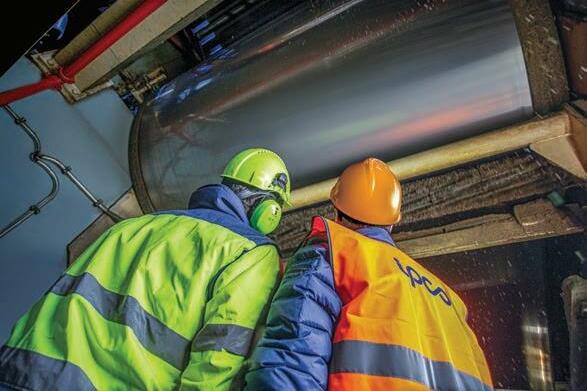
With a global service network, IPCO’s teams can also provide immediate support if a problem does occur. And more serious issues can be handled by IPCO’s Press Priority Team of specialists who can provide practical support anywhere in the world at short notice.
This same expertise has also led to the development of a range of service tools that enable IPCO engineers to return press belts to full working order with minimal downtime.
One of these is the IPCO Shotpeener Pro tool, a portable device used to remove the deformations caused by the stresses placed on the belt in high speed thin board production. And in the case of damage caused by glue lumps, repairs can be carried out using the IPCO QuickDisc Plus 500, a self-contained cutting and welding system that is used to remove and replace damaged areas up to 480 mm in diameter.
LEDINEK
SmartLam North America, the first U.S. manufacturer and largest manufacturer in North America of cross laminated timber (CLT), announced it will build a $50 million glulam manufacturing facility in Dothan, Ala. The new facility will manufacture annually 84MMBF of large glulam beams and columns that are required to properly serve the mass timber market. The new glulam facility will be 100% operational in October of 2024.
Rather interesting is SmartLam’s new approach to automated high capacity glulam production by use of cold glue press technology. This technology is not yet common in North America but has been used throughout Europe for decades in automated high-capacity glulam production. To achieve its goal SmartLam has chosen to partner with Ledinek, a specialist and a global leader in this technology to build a turnkey, state-of-the-art glulam facility.
At the core of new SmartLam glulam facility—three Ledinek presses with cold glue technology
SmartLam North America CEO Derek Ratchford states, “We are pleased to announce the new state-of-the-art custom glulam manufacturing plant which will be the largest custom glulam plant in North America. We were looking for a turnkey project pro-

22 • NOVEMBER 2022 • PanelWorld PRESSES
IPCO press belts and service for thin board production
CLICK HERE IF YOU HAVE NOT ALREADY OPTED IN!

CLICK HERE IF YOU HAVE NOT ALREADY OPTED IN!
vided by an industry leader in automated glulam beam and column manufacturing. After researching our options, we identified Ledinek as the best fit for our scope.”
Ratchford notes that Ledinek’s approach is based on cold press technology and allows automation with high flexibility and big production volumes. “Ledinek managed to please all our technical demands with unique solutions presented during project talks and will provide a complete solution based on three presses, all of them fully automated and with separate specialties that will allow our full flexibility.”
l Press #1: Z-Press
A 60-ft. edge glue panel press utilizes a fast assembly hot melt for edge bonding multiple lamination widths and allows production of split-lam beams at a later stage and in the same time reduces crook, twist and bow throughout the laminations to produce a high-quality product.
l Press #2: Rotopress
A 60-ft. rotary press with four press beds provides high production of beams/columns from 2x6 in. – 2x14 in. x 60-ft. that fit commodity and custom beam/column production.

l Press #3: Flexipress
A 60-ft. flexible press dedicated to large custom column sizes up to 24x24 in. and beams up to 24x78 in. x 60-ft. Provides ability to serve the mass timber industries growing requirements.
PAGNONI IMPIANTI
The Italian company Pagnoni Impianti has a long tradition of manufacturing press lines for flat panels, such as HPL and wood-based panels (particleboard, MDF, OSB, plywood). This tradition includes a continuous commitment to technical innovation and developments to meet the newest market requirements.
Thanks to this attitude Pagnoni Impianti can supply the most updated technology in the pressing processes. For TFM press lines, as an example, the company has developed an Embossed in Register application for the imprinting of deep structural patterns on surfaces of wood based panels such as high density MDF, featuring presses able to reach 600-700 N/cm2 (850-1000 PSI) and a very sophisticated and reliable multi-camera vision system.
Besides the state-of-the-art applications, Pagnoni Impianti is known worldwide for traditional TFM lines, featuring a pressure equal to 350-400 N/cm2 (500-580 PSI): One of these lines will be supplied in the next months to the company Seripanneaux, located in the south of France, where two Pagnoni Impianti single-opening press lines for particleboard production are already operating.
HPL presses have always been the Pagnoni Impianti specialty. The ability to supply complete turnkey plants makes the company a world leader in this area: The installation of a complete factory, including heating system and finishing line, is in progress in Uzbekistan.
In the field of HPL, Pagnoni Impianti has also developed an extremely reliable line, called Quickline, particularly suitable for the production of compact panels, equipped with a press with a few openings and an optimized layup system: Only two operators are needed to run the whole line. Production capacity of such 4/6 opening press lines is nevertheless very interesting thanks to very fast hot/cold cycles, shorter than 30 minutes. This performance can be achieved by means of powerful thermal systems of the latest generation equipped with the most sophisticated systems for heat recovery: Pagnoni Impianti can supply the whole equipment.
Always taking the compression force of the press and the speed of the hot/cold thermal cycle to extreme limits, Pagnoni Impianti has created a prototype unit for the production of panels, upcycling agricultural waste streams without the use of chemical resins, but only activating the gluing elements contained in the waste through the combined action of high temperatures and the “squeez ing” effect of very high pressures.
Today, despite the erratic international situation, Pagnoni Impianti’s portfolio of orders is full for the whole incoming year. This growth forecast and the recent shift of the Euro-Dollar exchange rate make Pagnoni Impianti firmly determined to enter the U.S. market with its press line for melamine lamination and HPL production.
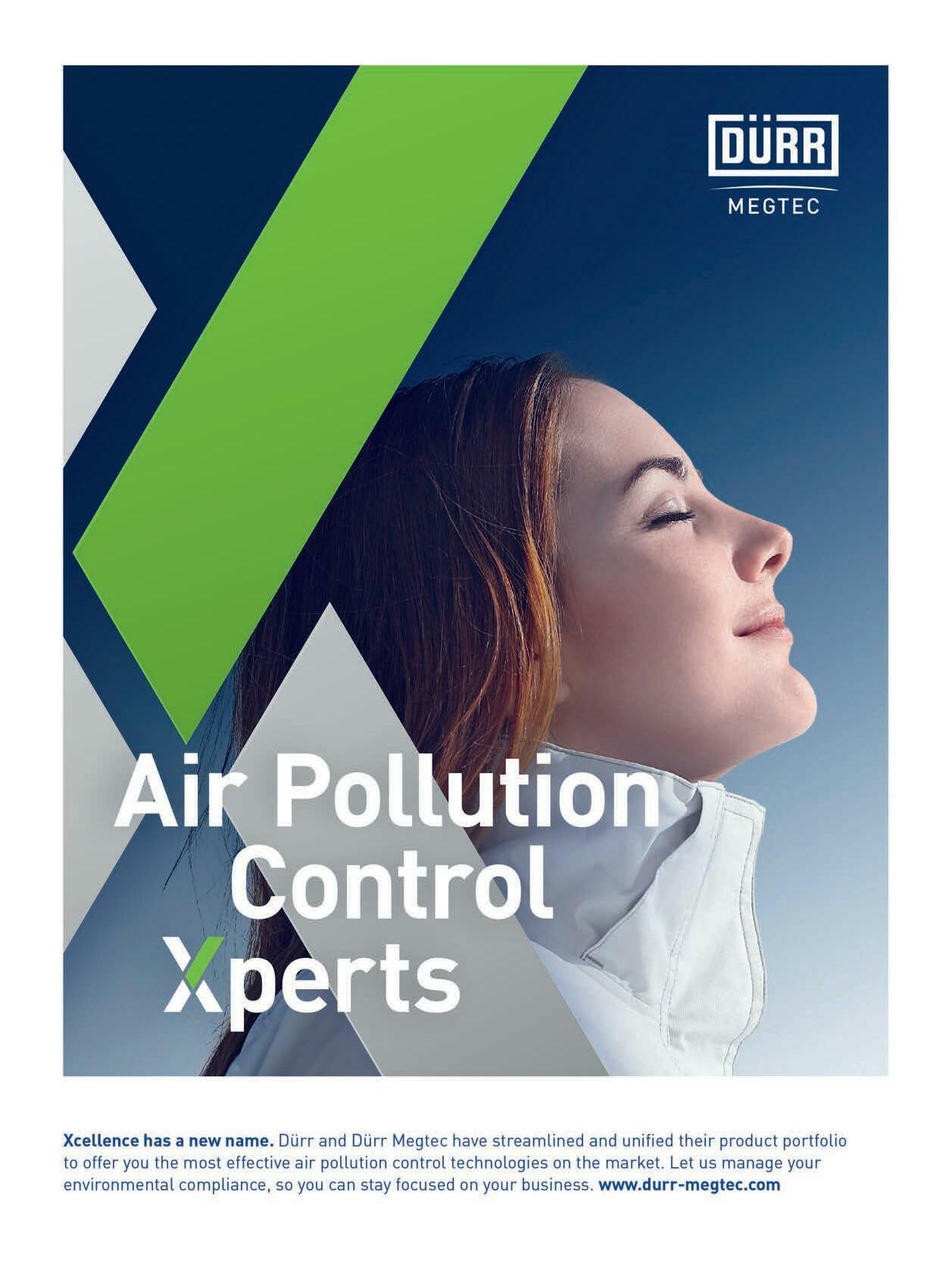
24 • NOVEMBER 2022 • PanelWorld PRESSES
Pagnoni eyes U.S. market with laminate press lines.
CLICK HERE IF YOU HAVE NOT ALREADY OPTED IN!

CLICK HERE IF YOU HAVE NOT ALREADY OPTED IN!
SHERDIL PRECISION
Sherdil Precision and presses go hand in hand. From its inception in 1993, Sherdil has formed a niche in the industry with their impressive in-house equipment capable of handling large scale machining, custom equipment building, and of course their specialty product: heating platens.
Sherdil Precision is best known worldwide for their high quality, precision heating platens for all industries. Inside their facility you will find two large CNC planer mills, two custom gun drills, and five overhead cranes totalling 120 tons. With the latest addition of a Cincinnati MAG U5-1500, their machining capabilities have now expanded to 72 in. H x 144 in. W x 744 in. L. Always looking to grow and evolve has given Sherdil the edge to stay relevant in an ever changing industry and given them the opportunities to build exceptional products.
Owner and founder Tarlok S. Kainth has a strong background in the press industry starting at Pathex International in 1976 and eventually running the North American division at Dieffenbacher. His 40+ years of experience in the press industry has given Sherdil Precision the reputation for being able to troubleshoot any project whether it be refurbishing and retrofitting old presses, designing new custom builds, or developing research for new technology.
Some of Sherdil’s current projects include refurbishing two press lines (4 ft. x 10 ft. and 4 ft. x 12 ft.) and supplying new platens, guidance system, and engineered drawings for a pipe header assembly; designing and supplying the press lines for three new multi-opening laminate presses; and completing an R&D project for a contact oven press for aluminum blanks to be used in the automotive industry.
TAIHEI MAHINERY WORKS
Soon, a 120-opening horizontal hot press will be delivered to a customer in Japan and installed! This is, of course, a replacement for an existing vertical press as the customer has recognized the value of the Taihei horizontal hot press.
The pressure applied to the panels by hot platen is uniform at all openings, and the thickness of all compressed panels is less than the thickness unevenness of the veneer. This is because conventional vertical presses require the thicker steel to prevent deflection of the hot platen. Therefore, the more opening numbers the press has, the more the weight of the hot platen will be applied on the lower panel. As a result, the thickness variations of the panel occur.
Once this press has been shipped, a larger press (4 ft. x10 ft. 120-opening) will be assembled and delivered to users who require extreme safety in press operations. The power required for the entire press is halved from the conventional presses, as no power is required to lift the hot platen.
Everyone wonders about the thickness of the hot platen. For standard presses, we are proud to say that less than one inch thickness is technically feasible. Why so thin? The answer is that sufficient amount of heat is supplied to the panel from the hot platen, and the limited installation space can accommodate many openings.
In the September issue, we introduced a 6-meter hot platen, which is also slightly over one inch thickness. This is a technology that only we can make possible.
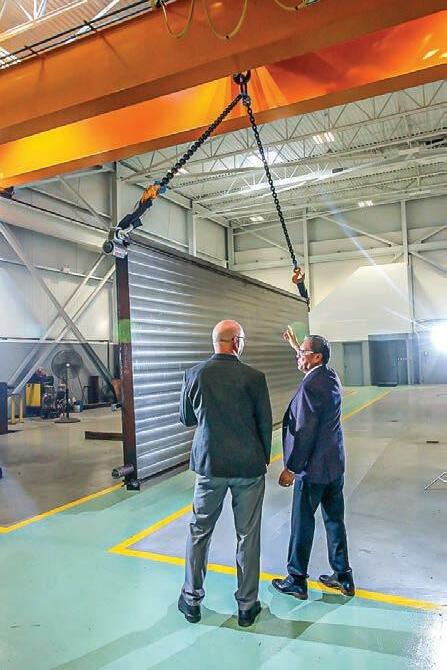
The compressed cycle of the press is determined by the number of press openings and the thickness of the product. Even if the number of press openings is 120, pre-pressed panels can be inserted into the press without any problem if they are defined by the general Performance Category.
The troublesome task of inserting panels by two layers can be avoided by using this multi-openings hot press. We expect this horizontal hot press to contribute to the development of the plywood industry in U.S and throughout the world.
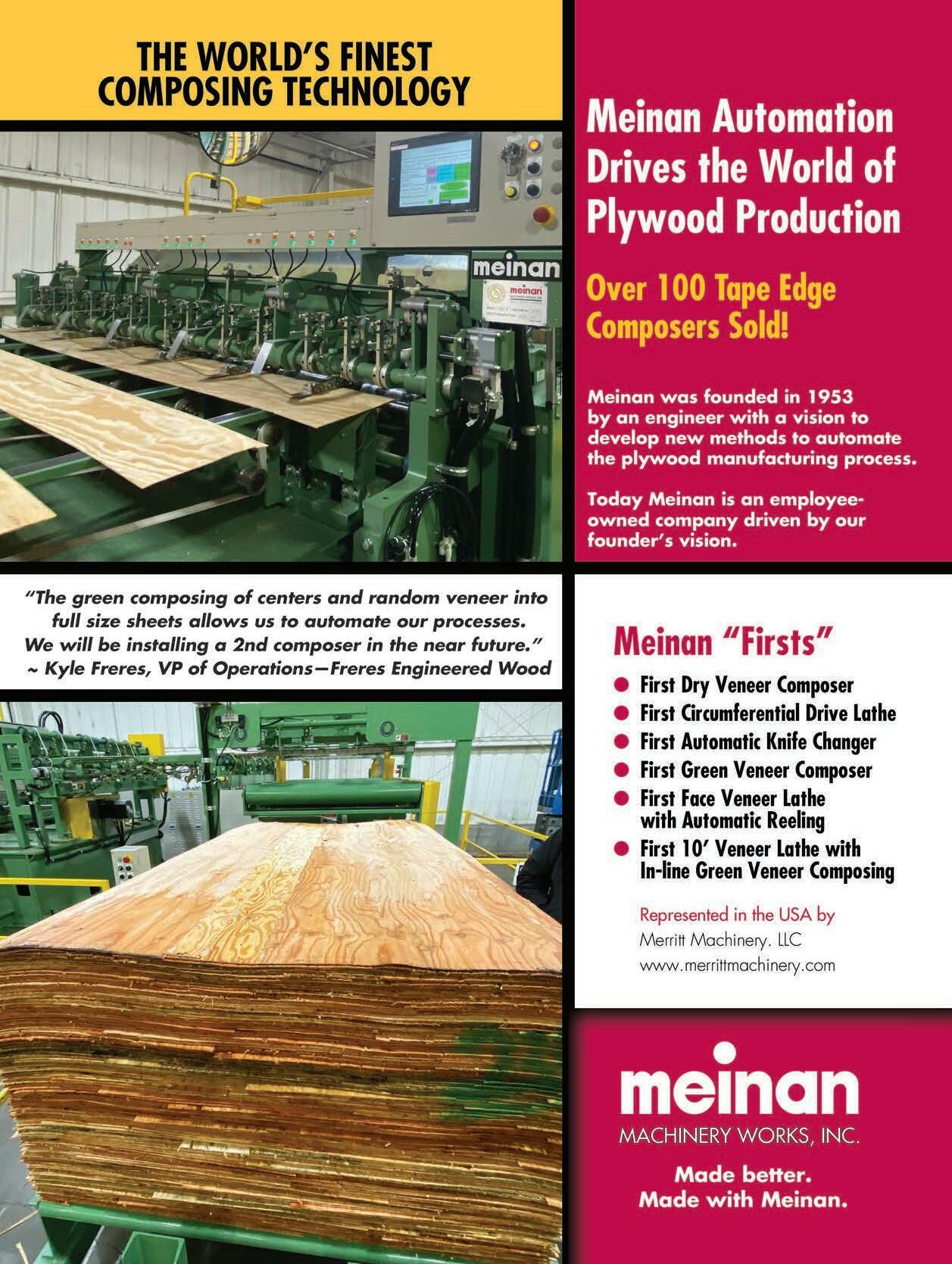

26 • NOVEMBER 2022 • PanelWorld PRESSES
Taihei horizontal hot press, 120-opening
Sherdil Precision heating platens for multiple industries
CLICK HERE IF YOU HAVE NOT ALREADY OPTED IN!

CLICK HERE IF YOU HAVE NOT ALREADY OPTED IN!
USNR
USNR proudly continues the tradition begun by Washington Iron Works and Pathex, manufacturing presses for OSB, MDF, particleboard and other composite products. With 24/7 service and smart upgrades, we can help you significantly improve your press operation and manufacture higher quality products while reducing maintenance.
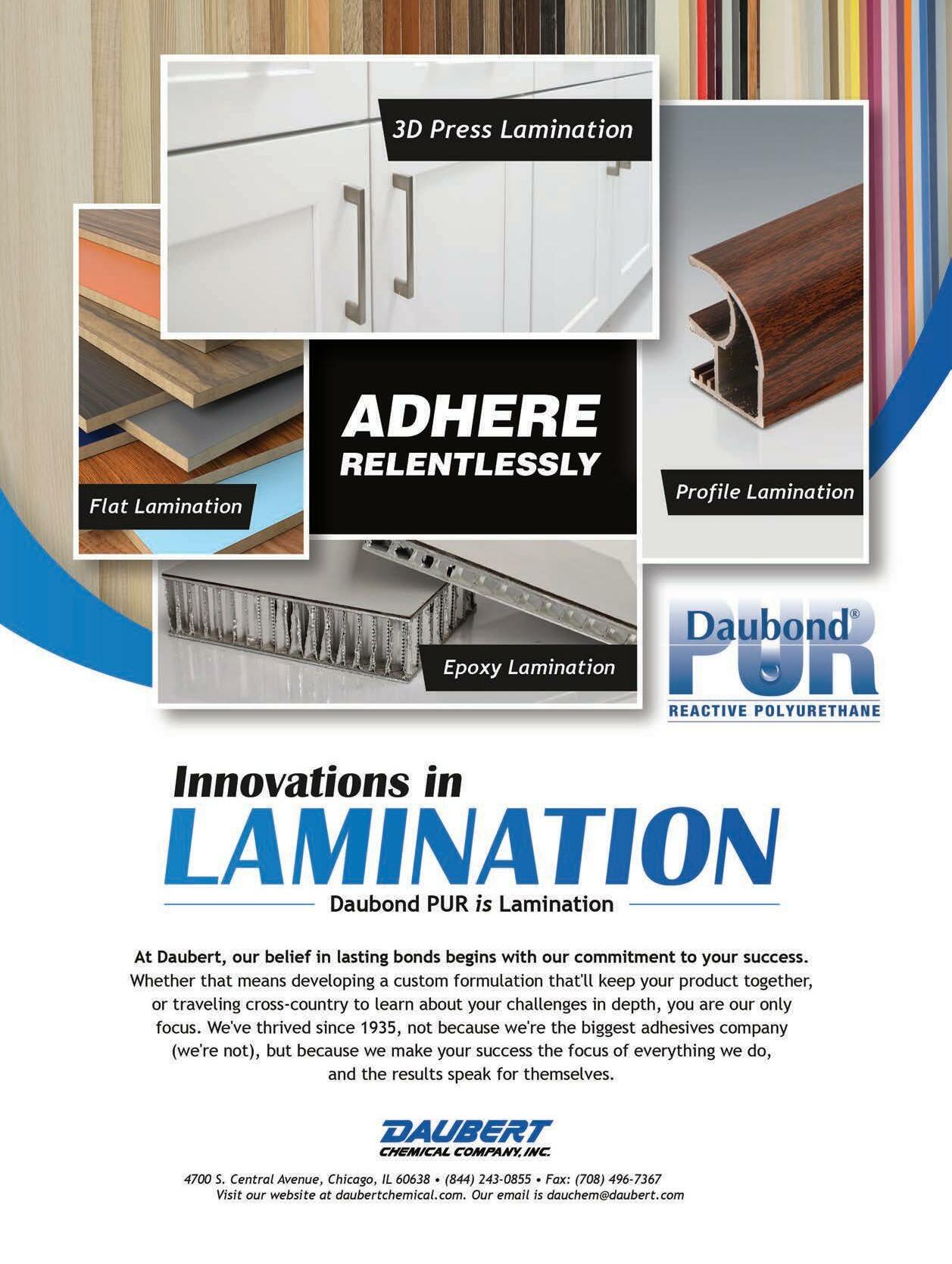
l Renew your press performance with electric prefill valves.

Easy Shift Synchronous Valve Control provides servo-valve capability for precisely metering large volumes of oil synchronously through multiple OSB press pre-fill valves. Easy Shift control converts the very large and difficult-to-adjust pre-fill valves into precise servo-controlled valves, by driving the control spool with precision servo motors. Accurately metering large oil flow volumes, despite temperature-induced change in oil viscosity or a temporary lapse in oil hygiene as result of mechanical wear, results in uniform positioning of the moving platen. Reliably positioning the moving platen during the curing process improves board quality. The system improves the ability to manufacture a better-quality product, create a safer workplace, and reduce the frequency of oil spillage.
l Centralized hydraulic power reduces shock.
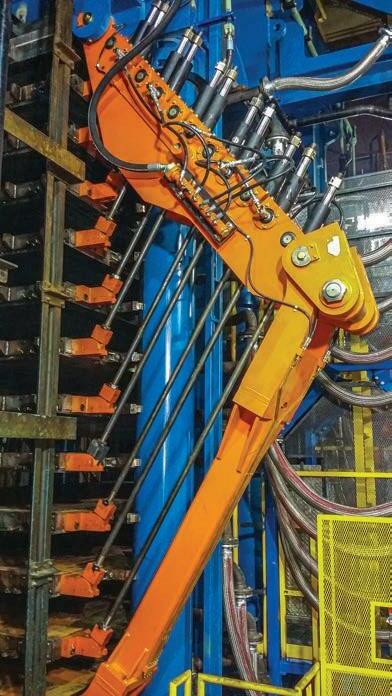
Proportional control increases system reliability and reduces maintenance by eliminating shock that is often present. This approach not only improves performance but also results in significant time and energy savings. Proportional control allows for a more exact control of decompression rates and uniform distribution of forces. Sequencing the pre-fills is also an important factor. Board quality can be improved by programming press closing speeds along with the compression rate for each board size. Most presses can realize energy savings of 1 to 1.5 million kilowatt hours per year.
l New hanger assembly for longer lifting lug life
USNR offers a newly designed hanger lug assembly for attaching the Simo closing lifting rods to the hot platens. The new design incorporates a removal cap on the lifting lug which contributes to longer lug life and faster pin and/or bearing replacement. The pin and lifting lug rod end can be easily removed from the press as one unit and worked on at ground level, reducing man hours working in the air.
It all adds up to energy savings and the best ROI for the money.
WEMHÖNER
Rheinspan GmbH & Co. KG, Germersheim, Germany, has laminated the first board on its new and now the second Wemhöner shortcycle press line in the factory. The new press line will primarily produce boards of high quality. One topic here is panels with synchronous pore (EIR) on both sides. The press was designed for a pressure of 700 N/cm² and formats up to 2,250 x 5,600 mm. The focus is on widths of 2,070 mm to 2,200 mm. The lengths will vary between 4,100 mm and 5,600 mm. The first Wemhöner short-cycle press line was commissioned in 1999. The old press had a specific lamination pressure of max. 350 N/cm².
Alexander Kolb, Managing Director Rheinspan, comments:
“For us, this is the first big step towards high-quality melamine surfaces. The necessary process technology has come to us virtually ‘free of charge’ through our new joint venture partner Gruppo Saviola. By choosing Wemhöner as the main supplier for the press line, we have relied on reliable technology. The company’s mechanical engineering competence has been proven over decades and the wealth of experience around this technology is unique worldwide.”
Presses continued on page 61. 28 • NOVEMBER 2022 • PanelWorld PRESSES
USNR upgrades for smooth and reliable press operation
New Wemhöner short-cyle press line
CLICK HERE IF YOU HAVE NOT ALREADY OPTED IN!

CLICK HERE IF YOU HAVE NOT ALREADY OPTED IN!
wner and operator of nearly 2.2 million acres of timberland in seven states, six sawmills, and a plywood mill in St. Maries, Idaho, PotlatchDeltic leadership—in response to

lution from Raute, this 119-year-old company is looking forward to benefiting from the cost savings, enhanced panel quality, and improved ergonomics it delivers.
CHALLENGES
Prior to 2022, PotlatchDeltic relied on two repair lines staffed by a team of up to 12 operators. These operators identified panel flaws, routed out defects, and filled them using applicator guns. But, as Don Gimbel, Maintenance Superintendent at the St. Maries facility, explains, “It’s tough to apply the exact right amount of fill using these manual methods.”
The search for a better solution began in 2016. That’s when Plant Superintendent Allen Shoemaker began analyzing PotlatchDeltic’s established processes. “We knew we needed more data, and a lot of it,” Shoemaker says. “So we took panels off the repair line and scraped out the polyurethane. Then we measured the defects and compared the total
cost savings to be realized by eliminating repair material waste. Further, according to Plant Manager Larry Branson, “We were looking to provide improved consistency for our customers.”
The data also revealed how much PotlatchDeltic’s panel business could benefit from adhering to a more highly standardized panel repair process.
HUMAN ELEMENT
PotlatchDeltic also understood that some of its recruitment and retention challenges along the patch line could be traced back to its manual quality control processes. “St. Maries is located in a remote part of Idaho,” Gimbel says, “so hiring can be more challenging than in other areas.”
Moreover, the physically demanding nature of panel repair work contributed to frequent turnover. “Routing and working a fill applicator require repetitive motions that can put stress on our team members’ hands and wrists,” Gimbel ac-
O POTLATCHDELTIC CREATES VALUE THROUGH AUTOMATION OF PANEL REPAIR LINE Multiple repair heads and continuous panel flow make the Panel Repairing Line R7 effective. CLICK HERE IF YOU HAVE NOT ALREADY OPTED IN!
Ashlee Cribb, Vice President of the Wood Products Div., saw that an automated panel repair solution could not only help PotlatchDeltic minimize the hazards associated with operating patch line equipment but also place those operators in positions more suited to their talents. “Automation is a way for our team members to focus on activities that generate higher value,” she says.
SYSTEM RESEARCH
Equipped with a thorough understanding of their plywood facility’s capabilities, PotlatchDeltic’s leaders began the search for an automated panel repair solution that would help them achieve multiple objectives:


l Improve ergonomics for team members.
l Phase out inefficient manual panel repair and patching processes.
l Realize significant repair material
Achieve a uniformly high quality of repairs regardless of wood species or
Put their team members in the best position to succeed—and more fully
participate in the enterprise’s success.
This search eventually led them to Chile. There, they visited an Arauco mill to see how that manufacturer leverages several different Raute solutions. “That sold us,” Shoemaker says. “Being able to see first-, second-, and thirdgeneration panel repair lines in action, compare their features, and track the evolution of that technology—that experience was invaluable.”
Branson and Shoemaker were particularly impressed by Raute’s defect analyzers. “Raute demonstrated to us that their equipment could be finetuned to handle the wood species (Douglas fir, larch, pine) we process,” Shoemaker explains.
RAUTE R7 SOLUTION
The fieldwork completed, PotlatchDeltic decided to invest in Raute’s Panel Repairing Line R7. This solution appealed to Shoemaker and team due to its high capacity, continuous panel flow, multiple repair heads, extremely accurate defect detection (powered by 3D scanners and high-resolution color cameras), precise application of repair materials, and ease of operation. With the potential to be supervised by a single operator, the Panel Repairing Line R7 can deliver up to 65% in repair material savings. Operators can also use Raute’s MillSIGHTS data-capturing tool to automatically optimize production and perform preventative maintenance.
COLLABORATION
After visiting Raute’s headquarters in Finland to conduct factory acceptance testing, PotlatchDeltic finalized their purchase. Raute technicians then disassembled the entire R7-Series panel repairing line and shipped it to Idaho.
Those technicians followed the equipment to its final destination, then worked closely with the PotlatchDeltic team to set it
“It’s been very rewarding to see all our efforts come together,” Gimbel says. “Even though we had equipment coming here from halfway around the world, it arrived without a hitch. And the team that joined us from Raute worked very well with our people.” Branson concurs: “The most satisfying part of this whole project has been working with Raute. The communication, the installation, the testing, the training—everything has been first-class.”
Gimbel also reveals that the installation of the Panel Repairing Line R7 has created a palpable sense of excitement at PotlatchDeltic’s St. Maries plant. “We’ve assigned four operators to work the new line, but people across the mill and the company are very interested in getting involved in this project.”
Cribb is one of those people. “I joined PotlatchDeltic midway through this project,” she explains. “But I had seen Raute’s equipment at work at other mills. When I learned that we would be installing the Panel Repairing Line R7, I was very excited. I knew it was going to make a positive difference for our enterprise.”
According to Shoemaker, PotlatchDeltic is already reaping benefits. “We’re saving on repair materials, and we’ve been able to reassign most of our repair line operators to other roles. So we’ve seen safety mitigation as well,” he says. “It’s early days, but these wins prove that automation is a key to our success now and in the future.”
For Cribb, that future is one in which automation plays an increasing role in helping PotlatchDeltic achieve its mission. “We want to grow and produce the forest resources that build a foundation for our lives and improve the communities in which we live and work,” she says. “To make those things happen, it’s critical that we find ways to continue to automate and to use accurate, consistent data to drive better decision-making. Raute’s shown themselves to be a vital partner in these efforts, and we look forward to strengthening that partnership as we integrate the Panel Repairing Line R7 more fully into our operation.” PW
Article and images supplied by Raute and PotlatchDeltic. Visit https://www.raute.com/ lines-and-machines/machines/panel-repairing
PanelWorld • NOVEMBER 2022 • 31 CLICK HERE IF YOU HAVE NOT ALREADY OPTED IN!
JANUARY
Taking Stock
Lend Me Your Ear. Page 3.
Martco Maintains Focus On Culture And Goals During Bizarre Times
Martco CEO Roy O Martin III provides insight into company operations and industry developments. Page 16.
Paper Industry Veterans Denounce Performance Of Paperboard Wall Sheathing
In recent years, OSB has begun to lose wall sheathing market share to a new panel type. Page 20
2022 Directory/Buyers’ Guide. Pages 34-72.
MARCH
Taking Stock
Dear Fred Fields, From Kenneth Ford. Page 3.
Despite Challenges, And That Virus, Roseburg FP Chester EW Comes Alive
Sticking with a process it knows— based on its Northwest operations—Roseburg Forest Products has its South Carolina LVL SYP mill on-line and going strong. Page 12.
Producers Navigated Changing OSB Market Dynamics During Past Two Years
From production reductions to record prices to long-term sustained demand outlook in barely 24 months. Page 22.
PELICE Preview. Pages 28-52
Ingenuity, Innovation Within The Veneer-Based Industry: A Report From The Field
2022 EDITORIAL INDEX
The softwood veneer and plywood industry appears to have found new momentum, as it always seems to. Page 54.
MAY
Taking Stock
Is This Really Happening? Page 3.
Murphy Company Upgrades Output, Quality At Foster Veneer Workhorse veneer producer is a key player in West Coast EWP markets. Page 14.
Keynote Speakers Come Up Big At (In-Person) PELICE 2022 In Atlanta Pre-and-post COVID mill project developments and producer company growth and diversification highlight talks at the eighth Panel & Engineered Lumber International Conference & Expo. Page 22.
Quality Control. Pages 32-47.
JULY
Also, robotics investment improves quality while making labor more manageable. Page 18.
PELICE 2022 Brought Everything From Taguchi To Board Quality Control
Part Three of PELICE coverage. Page 24.
Second Look
Chester Engineered Wood. Page 30.
IWF Atlanta Preview. Pages 34-42.
Timber Processing & Energy Expo Preview. Pages 44-60.
NOVEMEBER
Taking Stock
Looking Back At 2022. Page 3.
Six Action Steps For Veneer-Based Producers To Improve Recruiting & Retention
Taking Stock
Peanuts And Crackerjacks. Page 3.
Scotch Makes Commitment In Rebuilding Waynesboro Veneer Plant Facility is rebuilt, back up and running only 14 month after devastating January 2021 fire. Page 16.
PELICE 2022 Subject Matter Ranged From Legal To Global Part Two of PELICE coverage. Page 26.
Fire Prevention. Pages 36-37.
SEPTEMBER
Taking Stock The Show(s) Must Go On. Page 3.
New Short Cycle Press Takes States Industries Plant To New Quality Level, Sharpening Customer Focus
“Six-way-staffing” can benefit laborintensive operations that experienced pandemic and post-pandemic personnel challenges. Page 12.
Presses. Pages 20-28.
PotlatchDeltic Creates Value Through Automation Of Panel Repair Line
In response to the increasing cost of repair chemicals and shortage of skilled labor, the company began researching ways to optimize their plywood panel repair lines. Page 30.
All Said And Done: Fifty Speakers Brought Their Expertise To PELICE
Part Four of PELICE coverage. Page 34.
Panel Industry Percolates At TP&EE. Page. 40
32 • NOVEMBER 2022 • PanelWorld
CLICK HERE IF YOU HAVE NOT ALREADY OPTED IN!
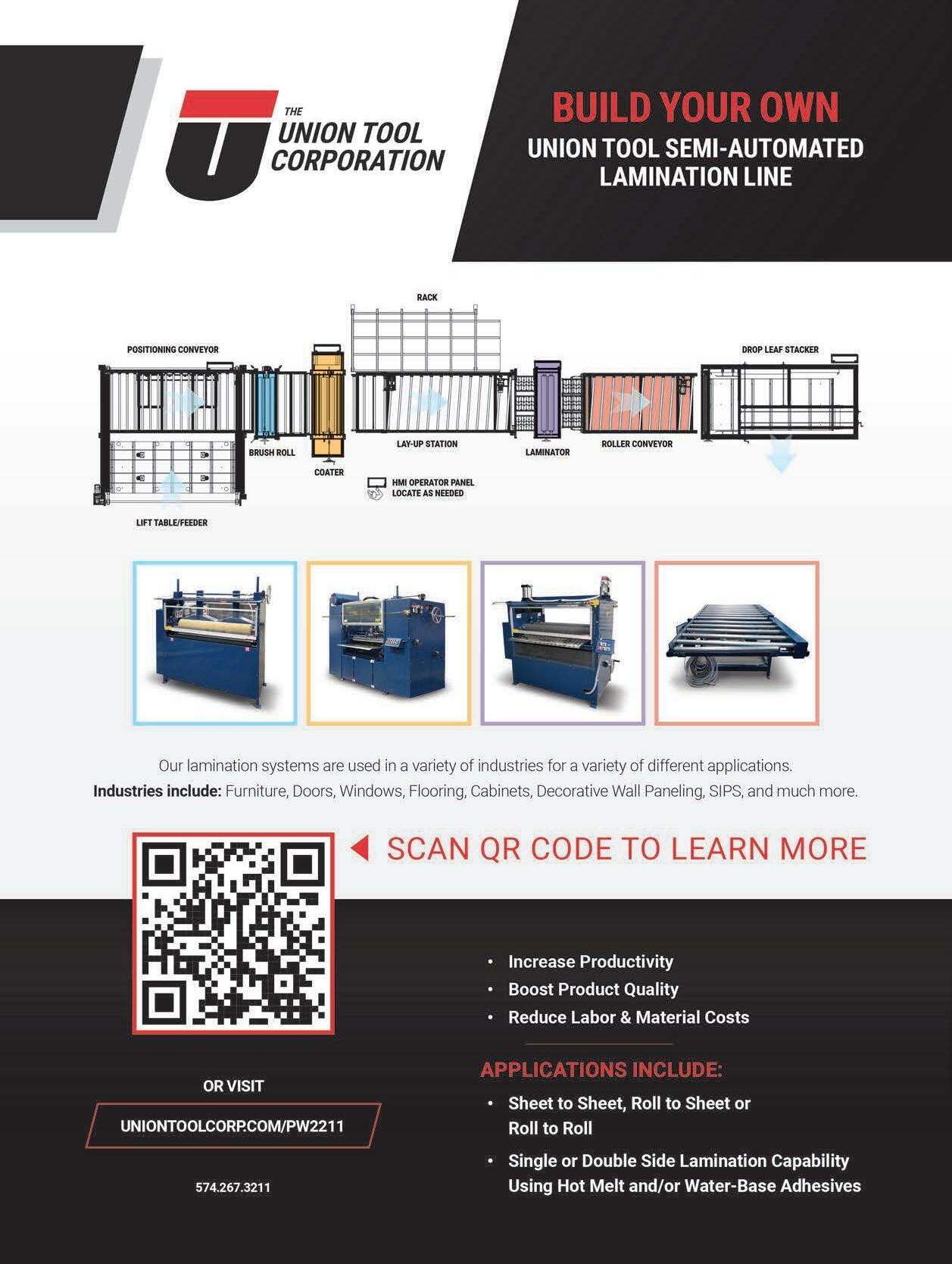
CLICK HERE IF YOU HAVE NOT ALREADY OPTED IN!
gineered Lumber International Conference & Expo (PELICE) held this spring and hosted by Panel World in Atlanta March 31 to April 1. The first three parts appeared in the May, July and September issues. PELICE 2024 will be held March 14-15, 2024 again at the Omni Hotel at CNN Center in Atlanta.

ATLANTA, Ga.
Anna McCann, president of Merritt Machinery and the U.S. representative of Meinan Machinery Works, led a panel session on recent installations of new Meinan lathe and composer technologies.
McCann first reviewed the history of Meinan, founded in Japan in 1953, and its numerous product innovations through the years, including random dry veneer composing, leading to the automated lathe line with in-line green veneer composing in recent years.
She cited the numerous advantages of the Meinan lathe line, including smoother veneer quality, higher recovery and energy savings, and pointed to attributes of the Meinan automated green end including no log spinouts, fully automatic knife changer, full sheet stacking by moisture content, automated clipping and in-line green veneer composing, including the “world’s first 10 ft. peeling line with in-line green composing.”
Doug Pauze, president of Coastland Wood Industries, Nanaimo, BC, provided his insights on Coastland’s Meinan “hybrid” installation, including
the drying process. He noted minimal dryer shrinkage and no telegraphic
Kevin Nesbit, national sales manager with Player Design, Inc. (PDI), spoke on innovative low ash biomass energy systems for wood products plants, and in particular about PDI’s burner technology.

He pointed to numerous features such as vertical combustion, center fed fixed grate slope circular burner (3200°F refractory bricks), screw augur feed, multi-stage combustion with customized air control, automatic ash removal, green or dry fuel, abort systems.
Nesbit reviewed several installed operations such as a new 45MM BTU green fuel combustion system at a 100% hardwood (shavings, sawdust chips) operation where the capacity of
34 • NOVEMBER 2022 • PanelWorld
Coastland’s Pauze addresses upgrades.
CLICK HERE IF YOU HAVE NOT ALREADY OPTED IN!
and better drying control; as well as fuel flexibility, including utilization up to 60% MC. Each dryer or kiln can be supplied by an individual burner, allowing for continued plant operation of other dryers during maintenance or downtime.
Tom Wechsler, president of Wechsler Technologies & Engineering, spoke on his company’s new CenterFire wood fuel suspension burner.

Wechsler addressed the pros and cons of scroll and cyclonic suspension burners and why his company has developed a new burner, mainly because of existing older technologies, high frequency of shutdowns and limited combustion and temperature control.
The CenterFire is a compact design so it can fit in the space of most existing burners for easy replacement. Wechsler
hydrophobic phase within water and this dispersion is stabilized by a surfactant/co-surfactant; the hydrophobic phase has a high affinity for water insoluble VOCS, while the water phase has a high solubility for water soluble compounds, such as methanol.
Microemulsions result in lowering the Henry’s Law constant for water-insoluble VOCS, thereby lowering the liquid flow rates in the absorber, Govind said, adding that microemulsion abosorbers combined with bioreactors can biodegrade a wide variety of VOCS—water soluble and insoluble.
“The investment and operating costs for micoemulsion absorbers with bioreactors are substantially lower than” traditional methods, Govind concluded.
Grigorii Bunimovich, director at Matros Technologies, addressed RCOs, and in particular catalyst monitoring and maintenance. He pointed out that using catalysts in post-dryer RTOs provides substantial energy savings that well-justify the initial costs.
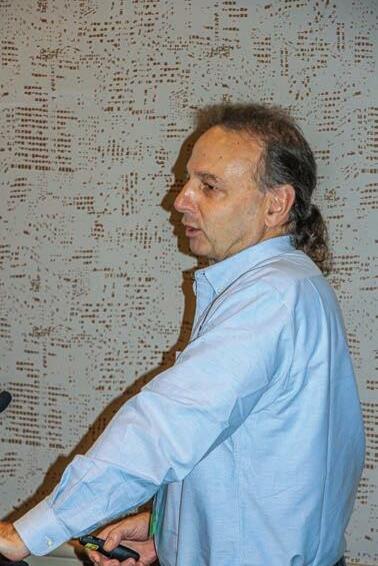
He said annual testing of worked catalyst samples generates recommendations on catalyst maintenance involving periodic regeneration via bakeout and gradual increase in RCO temperature.
He emphasized a new tubular reactor as part of catalyst activity testing that enables testing actual VOCs of interest with any type of commercial catalyst. The experimental destruction efficiency is close to one achieved in the RCO. He also pointed to the use of a stirred reactor for quick express testing with model VOCs.
Bunimovich said catalyst sample held for a year in the RTO operating after the wood dryer and WESP retains appreciable performance; and that for enabling catalyst application, the WESP should provide good PM removal and exclude liquid carryover.
More specifically he emphasized the efficiencies of base-metal catalyst that has demonstrated high efficiency for removal of methanol, formaldehyde and other HAPs and VOCs along with exceptional thermal resistance and high durability.
Steffen Bots, technical sales expert for Addinol Lube Oil, addressed the impact of friction on energy consumption. Looking at the big picture, Bots said 23% (119 EJ) of the world’s total energy consumption originates from tribological contacts (interacting surfaces in relative motion); 20% is used to overcome friction and 3% is used to remanufacture worn parts and spare equipment. By taking advantage of the
PanelWorld • NOVEMBER 2022 • 35
Wechsler talked about CenterFire.
CLICK HERE IF YOU HAVE NOT ALREADY OPTED IN!
new surface, materials, and lubrication technologies, energy losses due to friction and wear could be reduced by 40% in the long term (15 years) and 18% in the short term (eight years).
“On global scale, these savings would amount to 1.4% of the GDP annually and 8.7% of the total energy consumption in the long term,” he said.
He specifically addressed challenges
try, including operating conditions, production technology, variety of wood composition, and focused more on continuous presses, desiring minimized friction based on thicker lubrication film and friction modifier, and stronger wear protection by higher film thickness.
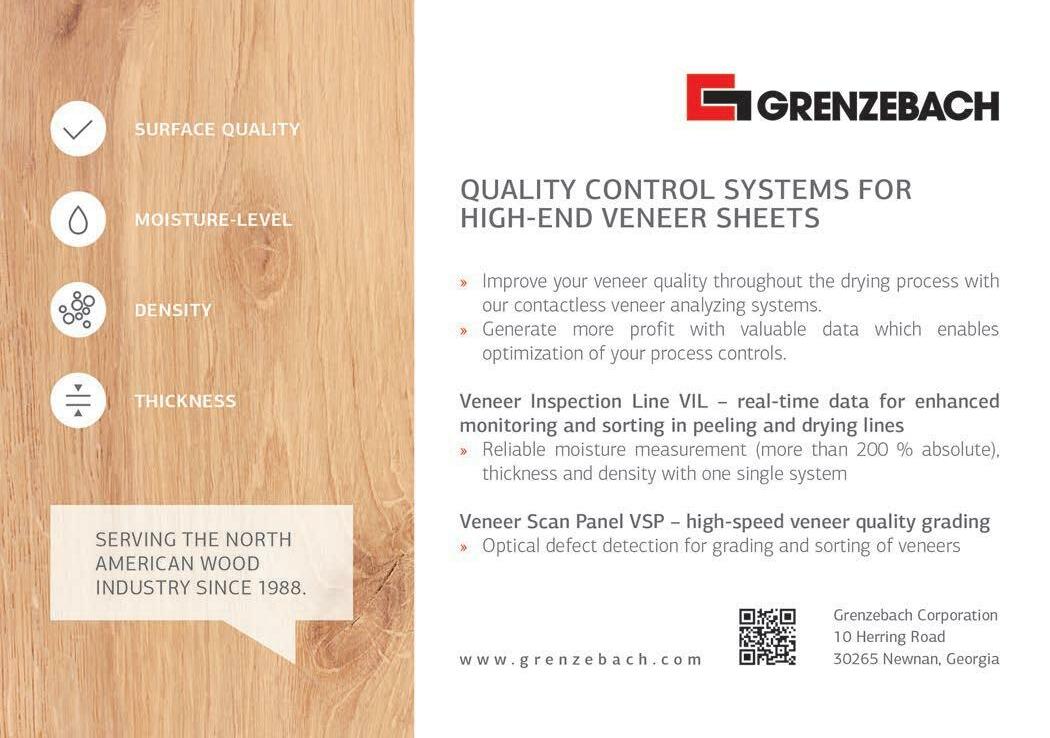
He pointed to a case study of a suc-
in Germany using Addinol Belt Lube HT, citing 30% less oil consumption due to optimal lubrication and 50% reduction of power consumption due to lower friction coefficient. He talked about Addinol lubricants (Eco Gear) for gearboxes, hydraulics, bearings and roller drums.

“Tribology is an underestimated dis-
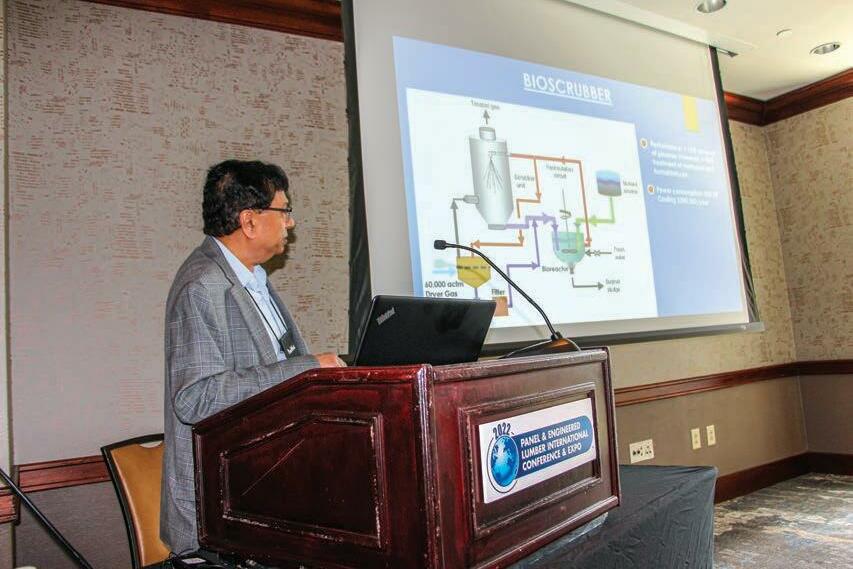
36 • NOVEMBER 2022 • PanelWorld
Bots peeled back Tribology. Govind dove into biotreatment of VOCs.
CLICK HERE IF YOU HAVE NOT ALREADY OPTED IN!
cipline but is an important piece of the puzzle to more efficiency,” Bots said. “Lubricants are not the problem, they are part of the solution.”
Thomas Brotski, principal at Harrison Group, and Matt Cowen, sales manager with KCF Technologies, spoke on optimizing forest products mills and how industry leaders are reducing downtime, increasing throughput and driving industry 4.0 strategies.
They pointed to three challenges facing the industry that are driving the adoption of new technologies, including demand increase, cost reduction and talent shortage. They discussed value drivers such as optimization of maintenance through PM quality checks and prioritization, and optimization of machines through definition of optimal SOPs. They discussed the “right” technologies and process (wireless protocol/shop floor machine learning/industrial grade hardware, etc.) from a dangerous and safe perspective. And concluded with the importance of personnel on the shop floor as part of the procedure from machine data to optimal plant operation.
Timothy Young, CEO and president of T.M. Young Institute and data scientist professor, spoke on the concept and use of Digital Twins as a key step in implementing machine learning and AL.
One key technology in ensuring success in implementing Industry 4.0 is supervised machine learning, Young said, enabling analyses of massive quantities of data. Digital twins mimic processes and human interactions by using simulations of the machine learning predictions—basically a virtual replica. For example, a control room operator relies on PLC logic from sensor data and human intuition from experience to optimize throughput while maintaining product conformance. A digital twin from machine learning algorithms mimics the decisions of control room operators for validation and may provide enlightenment for improved process optimization.
Young said “variable importance” is a key to digital twin development; that variation is cumulate, influences process targets, and is directly related to economic loss.
Wendy Owens, CEO of Hexas Biomass, discussed non-wood “green” boards and building materials. She defined “green” as better than netzero/do-no-harm life cycle; locally sourced; protects and improves local ecosystems; and supports local communities. She said there is growing
consumer demand for non-wood in combination with government promotion of “green” building materials.
She addressed the uses and advantages of several non-wood materials including coconut husk fiber, bamboo, hemp, and finally her company’s product, Xanograss, citing several benefits: low water use, climate resilience, no pesticides needed, no food crop displacement, EPA-approved, 15-year high yield from a single planting.
Further, she talked about hybrid or
100% Xanofiber particleboard and MDF meeting various standards in bonding, flexural property and water absorption, and as OSB with high resistance to mold and improved profile.

“Hexas’ goal is to make the highest and best use of all biomass,” Owens said. “We are developing IP, systems, and even a marketplace to do just that.”
Stefan Zöllig, principal at Timbatec Engineering, spoke about the dawning of a new day for an old product that has never come of age, at least not yet—
PanelWorld • NOVEMBER 2022 • 37
CLICK HERE IF YOU HAVE NOT ALREADY OPTED IN!
Scrimber, as a carbon sequestering raw material for mass timber products.

He cited the well known climate and carbon advantages of wood over materials such as concrete, brick and steel. “How to do you produce building material out of CO2?” he asked, then answered, “Our forests do produce materials out of CO2,” which is one of the environmental attributes for the rising demand of timber buildings—public, residential and commercial. And he pointed to the ample yearly forest growth worldwide, of which
sawnwood consumes only 10%.
Zöllig reviewed the production of Scrimber (now patented as the TimTek process) that originated with the Australia industrial research organization (CSIRO) in the 1970s, which entails basically crushing the log piece (scrimming) into interconnected strands, drying, resin application, drying, layup, pressing and cutto-finish as long fiber billets.
Zöllig pointed to CLT and glulam as potential markets and reviewed recent research efforts, feasibility studies and
promised investor finances, and offered a roadmap to a pilot plant and a standard plant by the end of the decade.
Patrick Donahue, building products research program manager at Natural Resources Research Institute, addressed the charter mission of NRRI—to foster economic development of Minnesota’s natural resources in an environmentally sound manner and promote private sector employment. NRRI has significant research and lab locations at Duluth and Coleraine, Minn.
He spoke about the National Science Foundation’s Innovation Corps (I-Corps) seven-week hands-on course geared to the understanding and potential value of technology and assessing the market opportunity for new technology. The course environment is fast-paced; teams are pushed and challenged.
In 2021 Donahue was awarded an ICorps grant and his course team focused on the development of a business for a multi-functional building envelope panel solution. The team interviewed more than 140 stakeholders across all aspects of the building construction value chain.
He said several lessons were learned: the construction industry is extremely fragmented; some customer segments are not willing to pay more for environmentally sustainable building materials; if innovations are going to succeed, a comprehensive communication strategy is key.
Especially timely was Richard Poindexter’s talk on wood products employment trends and how to keep employees engaged. Poindexter is president of Search North America. He immediately caught everybody’s attention with a real world example of wood products companies having to compete with fast food restaurants that are paying workers $16-$18 an hour.
However, job opportunities abound in the wood products industry, from executive to entry level, due to COVID, the retirement of Baby Boomers, organizational realignment and simply people looking for new opportunities and having the leverage to do so. He said workers today want to earn a good salary, develop their skills, have flexible hours and feel appreciated.
How do you keep workers engaged? Poindexter pointed to cross training, employee survey feedback, educational reimbursement, bonuses, recreational perks and constant emphasis on their safety.
“Based on employment and demographic data this pattern of more jobs than people to fill them may last for a while,” Poindexter said. PW
38 • NOVEMBER 2022 • PanelWorld
CLICK HERE IF YOU HAVE NOT ALREADY OPTED IN!

CLICK HERE IF YOU HAVE NOT ALREADY OPTED IN!
hile traditionally known as a sawmill show, the recent Timber Processing & Energy Expo experienced a healthy turnout from producer companies that also participate in the structural panel and engineered wood products sectors, including the likes of ATCO Wood Products, Boise Cascade, Coastland Wood Industries, Columbia Forest Products, Freres Engineered Wood, Georgia-Pacific, Hood Industries, Hunt Forest Products, Murphy Company, Pacific Veneer, Pacific Wood Laminates, PotlatchDeltic, Rainier Veneer, Rosboro, Roseburg, SmartLam North America, and Weyerhaeuser, to name some of them.
The event, held
at the Portland Expo Center in Portland, Ore., featured 170 exhibitors, 1,225 (non-exhibitor) registered attendees and another 900 exhibitor personnel. Produced by Hatton-Brown Expositions, an affiliate of Panel World magazine, the every-other-year event was last held in 2018 (due to the pandemic canceling the show in 2020). 2022 marked the fifth TP&EE since its inception in 2012.
“It has been the million dollar question for the Portland show as long as I can remember: Should the structural panel industry receive equal billing as the sawmill industry?” comments Rich Donnell, Show Director and Editorin-Chief of Panel World “We have never promoted it that way, and certainly there was far more sawmill influence at this TP&EE, but given some of the comments we’ve received since the show, we’ll definitely need to look at it moving forward.”
More than 110 wood producer companies sent representatives to the event. Several TP&EE exhibitors, such Altec, Westmill, MDI, Samuel, Signode, Taihei Machinery and
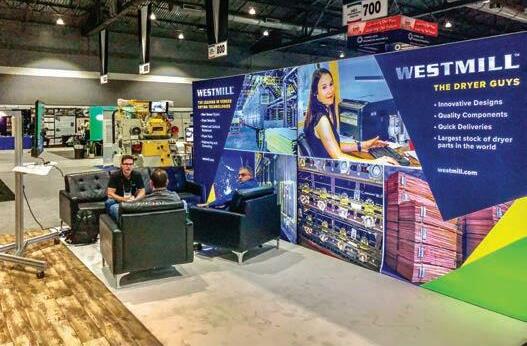
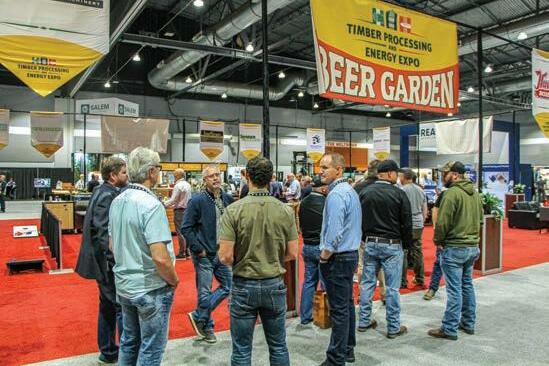
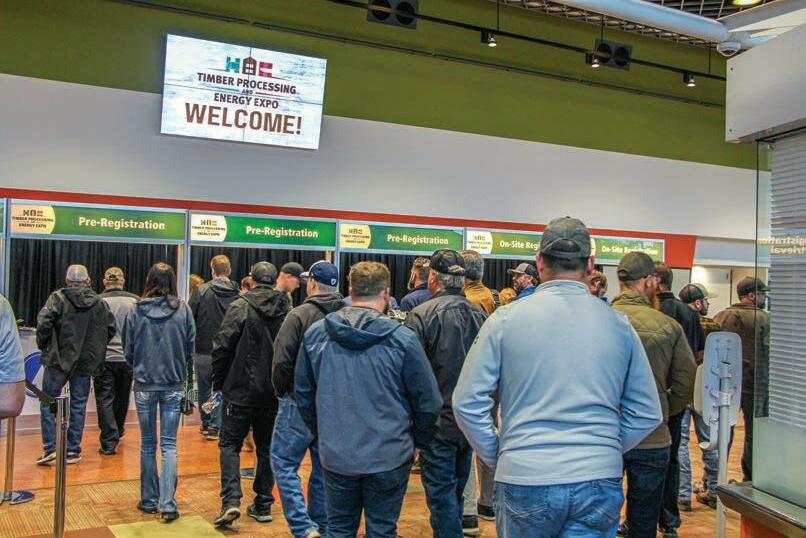
USNR, do considerable business in panel and EWP.
In addition to the exhibits on the show floor, one feature of the event that both panel and lumber segments enjoyed was the conference, From Forest to Frame: Mass Timber Developments, which featured 10 speakers, and which was followed the next day by a Mass Timber Tour of Freres Engineered Wood in Lyons, Ore. and TallWood Institute in Corvallis, Ore.
The conference included a panel discussion on Tracking and Transparency in the Forestry Supply Chain, moderated by Evan Schmidt, outreach and education manager, TallWood Design Institute. Also, Iain Macdonald, director of TallWood, spoke on The Oregon Mass Timber Coalition—Connecting Oregon’s Forests to Mass Timber Manufacturing; Jeanelle Leafblad, senior director, WoodWorks, addressed Growing Market Demand for Wood Products; Allan Czinger, senior account manager, USNR, spoke on Optimizing Sawmills for Mass Timber Production; Russ Vaagen, founder and CEO, Vaagen Timbers, talked about Mass Timber: From Early Adopter to Mainstream Buildings; and Derek Ratchford, CEO, SmartLam, addressed U.S. South Mass Timber Growth.
The next TP&EE is scheduled for September 25-27, 2024.

PW 40 • NOVEMBER 2022 • PanelWorld W PANEL INDUSTRY PERCOLATES AT TP&EE IN PORTLAND At left, Kyle Freres leads the mass timber bus tour that’s headed to Freres Engineered Wood in Lyons, Ore. Upper right, lines were long for a beer and a brat. Westmill hosted several veneer operators at its exhibit. Below, many mills encouraged their employees to come to the show. CLICK HERE IF YOU HAVE NOT ALREADY OPTED IN!
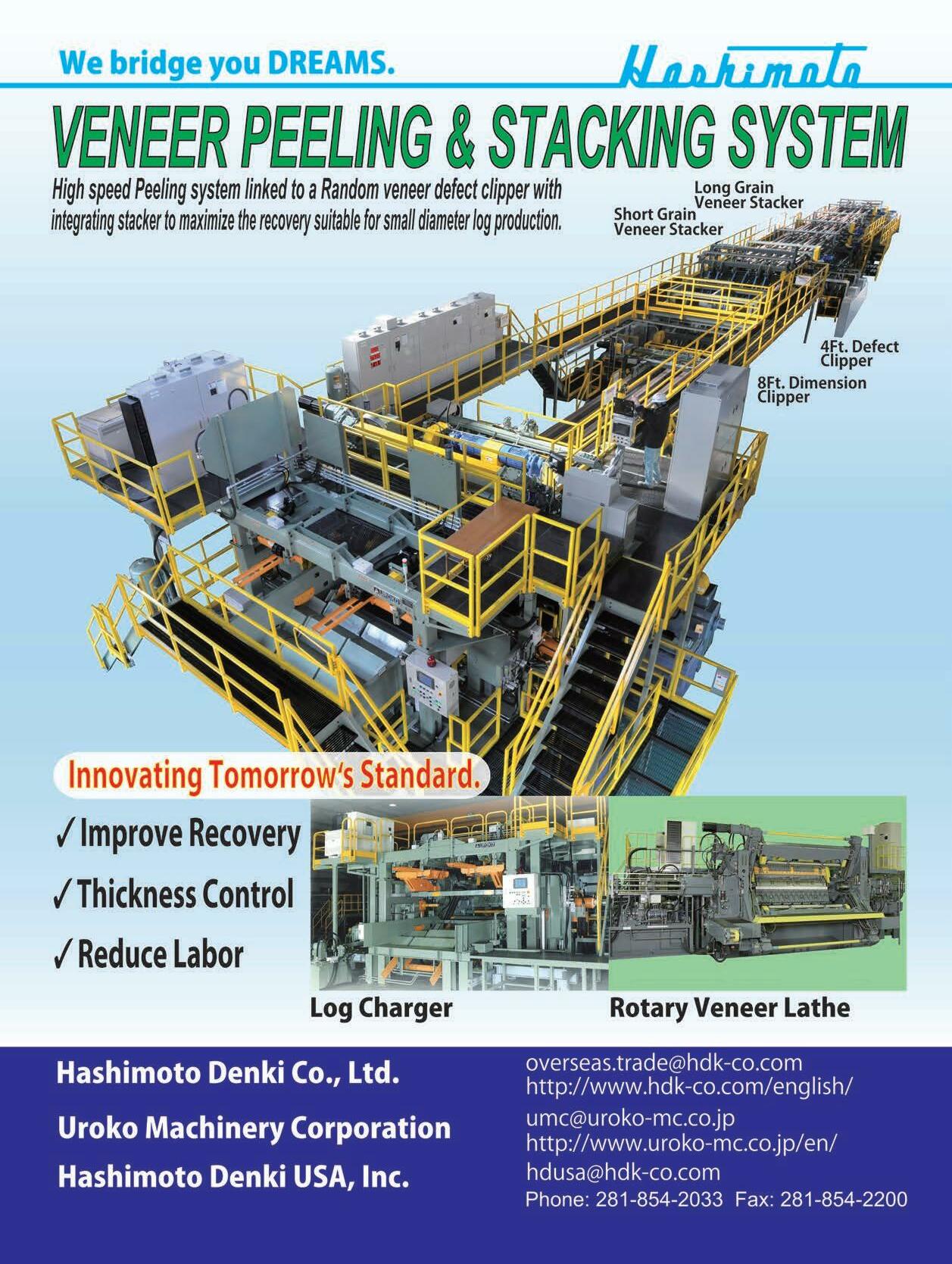
CLICK HERE IF YOU HAVE NOT ALREADY OPTED IN!
Founded in 1960 in the U.S., Jeld-Wen designs, produces and distributes interior and exterior doors, wood, vinyl and aluminium windows, wall systems and other housing components. Currently, the company employs 21,000 worldwide, and has manufacturing, distribution, and showroom locations across the U.S. and in 24 countries mainly in North America, Europe and Australia.
Jeld-Wen entered the European market in 1993. Since then, Jeld-Wen has grown to encompass brands across the continent. In the UK, the Jeld-Wen brand has been in existence since 1999, and currently it has five different factories across the UK, and among those is Penrith.
According to Andrew Taylor, Product Manager at Jeld-Wen, “Penrith consisted of three assembly lines, all 30 years plus. They were prone to breakdowns, obsolete equipment, and low
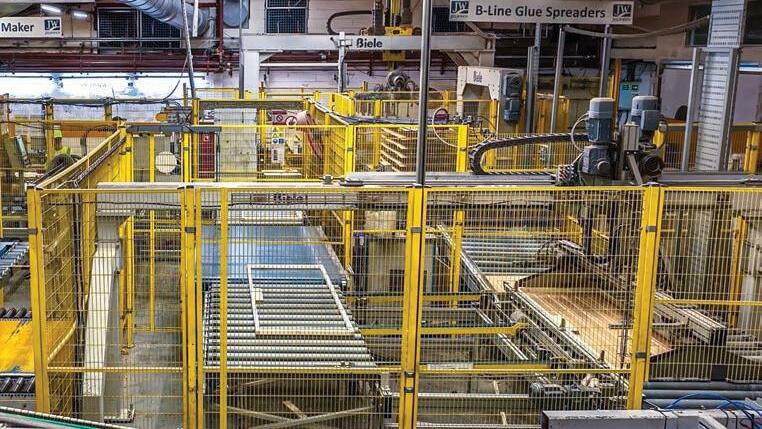

output. The decision was made to replace two of these lines consisting of the integrated frame making machine, core insertion, hot press and finally a

camera system.”
Jeld-Wen was looking for a customized solution that would automate their basic hollow-core and half hourfire doors manufacturing processes. The project goal was to provide at a first stage a complete press line that would increase productivity, and to design an artificial vision camera system to improve the quality control check in a second stage.
The main challenge lied in the flexibility and the high automation level required from the client, since the new line should be able to produce both basic hollow-core and half hour-fire doors at high speed. The other major challenge was developing such a customized vision system that would allow to detect up to 40 different type of defects.
In addition, there was limited space; this project would require a design solution to remove and replace two existing lines while maintaining production.
42 • NOVEMBER 2022 • PanelWorld
JELD-WEN AUTOMATES WITH CUSTOM TECHNOLOGIES PROVIDED BY BIELE GROUP Start of line feeding Frame assembly Frame skin door CLICK HERE IF YOU HAVE NOT ALREADY OPTED IN!
PROJECT
Biele Group answered the call and developed a complete turnkey manufacturing line for residential doors. The project consisted of two almost identical lines that included integrated frame making machines, core insertions, four hot presses and camera systems.
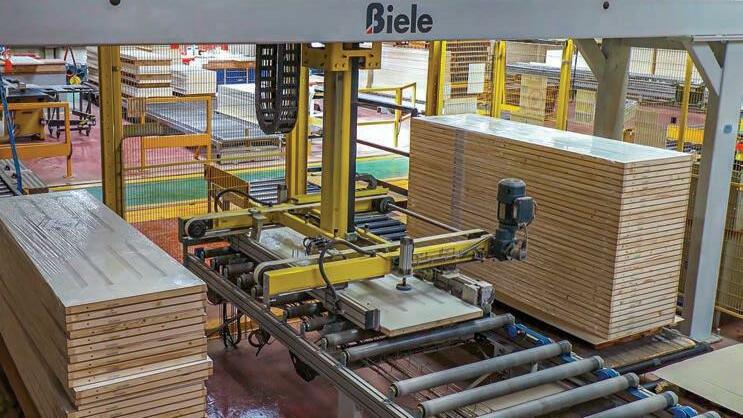
The production process begins by supplying skins to the assembly lines. Also, wooden stiles and rails are fed into the line. The skins are de-stacked, and they are glued as the stiles and rails are automatically placed together using a pick and place system in a hot melt glue system.
The door frame is then automatically constructed and presented to the skin, and afterwards the skin and the frame are transferred to the core insertion stage that is done manually so that quality check can be done. Meanwhile, the top skin follows it and is placed on top of it. This door is then presented to a pre-crush
press, and this is done to mutually deform the core with the panels and the skin.
These doors are then stacked into groups of 10 and they are then presented to a 10-daylight hot-press which is steamheated to 100ºC. The four presses present in the two lines maximize productivity thanks to the automated loading and unloading systems that allow maximum efficiency. After the pressing process, the doors are released and then fed individually into the Biele finishing lines, so that doors are trimmed to size and hardwood lippings are applied if necessary.
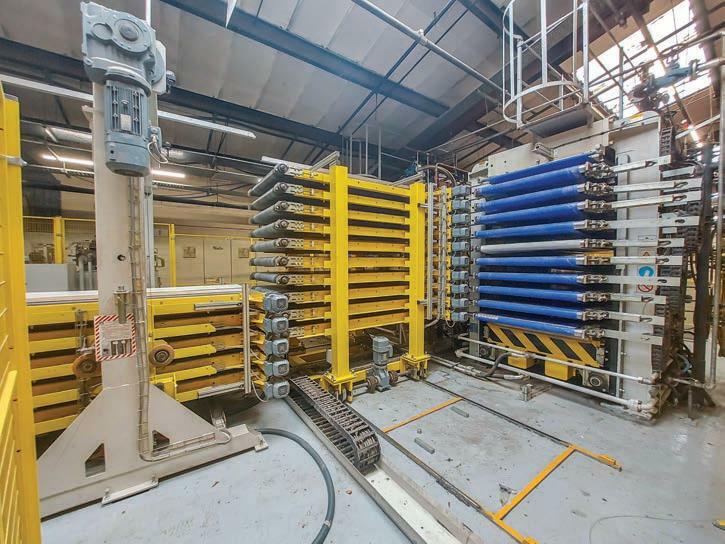
The doors then carry on to another Biele system, which is a camera & vision system. This system looks for imperfections, small damages, scratches, etc. This data is transferred to an endof-line stacker, and this stacks the doors for going to dispatch or stacks in a different stack for going to the repair area where it gets light repairs.
The customized vision system implemented on these lines were specifically
developed for this project. This cuttingedge technology integrates in a small form factor vision system (only 750 mm wide) 14 cameras to detect defects in all six sides of the doors.
The artificial vision equipped in these lines enable the system to detect up to 40 different type of defects. These imperfections include knot holes, resin pockets, skin delaminating, split timber, glue on face, water marks, trim damage, poor trim, loose lip, open joint or face decoloration.
The key to this technology is to merge and synchronize in only one vision system what normally would be done by means of three or four different systems. The other key remains how easily this quality control solution can be adapted to layout restrictions that each customer may have.
RESULTS
Thanks to the new door production lines, the client achieved a significant increase in production capacity. Taylor comments, “The old assembly lines at best could produce three doors per minute and were of a cellular system. The new lines are now completely integrated, and they produce five doors per minute.”
Taylor adds that after the commissioning, once they had gained experience working with the new lines, they implemented some little improvements “thanks to the engineering from Biele and ourselves, and we are now able to achieve 5.5 doors per minute. This is giving 45,000 doors per week on a 24/5 weekly system.”
From Biele’s perspective, this project has provided a valuable and enriching experience. The chemistry and collaboration between both technical teams has been outstanding from the beginning, and this has led into a fully customized press line for Jeld-Wen. Biele’s willingness to help Jeld-Wen to keep growing has resulted in new projects that Biele hopes will be as positive as this project.
According to Jeld-Wen’s Taylor, “Biele’s turnkey approach made them stand out from others. Their project management, their communication together with our project management team resulted in a flawless project. This has led us to use Biele for a current project which is going on now, and we will be looking at using Biele for a future larger project.”
Article and images provided by Biele Group and Jeld-Wen.
PW
PanelWorld • NOVEMBER 2022 • 43 Hot press
End-of-line stacker
CLICK HERE IF YOU HAVE NOT ALREADY OPTED IN!
ZIEGLER STARTS UP WFIB OPERATIONS
began just five months later on September 1, 2021.
“We are very pleased that our new Dieffenbacher WFIB plant had such a rapid and successful start,” explains Andreas Sandner, Commercial Managing Director at Ziegler Group. Dieffenbacher’s scope of supply for the complete plant included a fiber dryer, EVOjet M 2.0 gluing system, the forming station and forming line with prepress, a CSS Continuous Steam Press System, the raw board handling system, electrics and automation and the MyDIEFFENBACHER digital service platform.
tion at the Grafenwöhr site. Construction began in June. The 10-tonne-perhour capacity dryer is scheduled to go into operation this quarter.
GRENZEBACH RECEIVES FLEX BOARD LINE ORDER
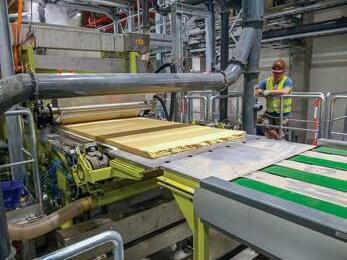
A complete wood fiber insulation board (WFIB) plant provided by Dieffenbacher for Bavarian Ziegler Group’s Grafenwöhr site is up and running less than one year after construction began. The line for rigid WFIB began production on August 30. Ziegler Group placed its order with Dieffenbacher on April 1, 2021. Despite a change of location at short notice from Bärnau, 50 km west of Grafenwöhr, construction of the new plant
“The change of location and the procurement crisis during the pandemic made this feat all the more remarkable,” Sandner says. “Our thanks go to the entire Dieffenbacher team, which overcame huge challenges to meet our requirements for product quality and energy efficiency.”
In addition to the WFIB plant just completed, Ziegler Group commissioned Dieffenbacher to supply a fiber dryer for flexible insulation mat produc-
Grenzebach reports that Germany’s biggest sawmill operation (name withheld) has found a way to convert its wood chips into another valueadded product. The company has teamed with process and automation specialist Grenzebach for the design, supply, delivery and integration of a production line for flexible insulation boards.

The new production center for wood fiber insulation boards consists of one production line for rigid insulation board and another line from Grenzebach for flexible insulation boards (flex boards). The combined annual capacity
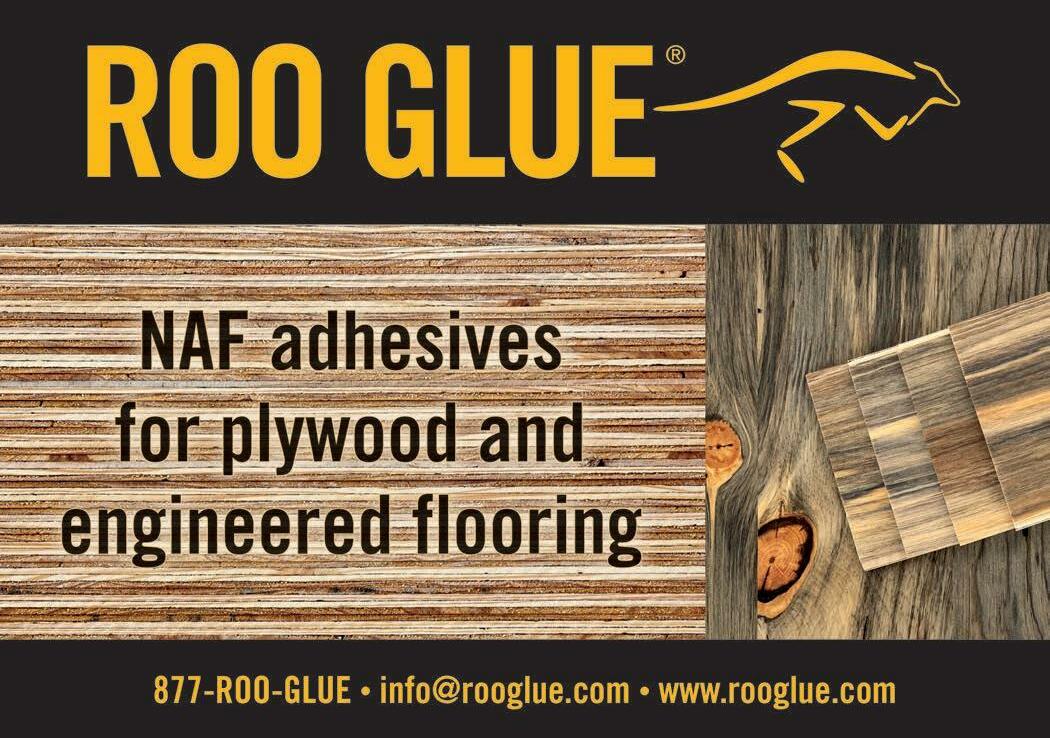
PROJECTS
44 • NOVEMBER 2022 • PanelWorld
Production of the first board at Ziegler Group’s new Dieffenbacher WFIB plant in Grafenwöhr, Bavaria, Germany
CLICK HERE IF YOU HAVE NOT ALREADY OPTED IN!

CLICK HERE IF YOU HAVE NOT ALREADY OPTED IN!
PROJECTS
of these two lines is approximately 2.2 million m³/year (77 million ft³), making the facility the biggest of its kind worldwide. The flex board line from Grenzebach is 8 ft. wide and has a capacity of 1.6 million m³/year (56 million ft³). The Grenzebach scope of supply comprises all process-relevant equipment and machinery, from take-over of the dry fibers to the cut master board, as well as complete installation and commissioning.
The flex board line is the key element of the number 2 production line, as it encompasses the fiber blending and metering section, fiber spreading and mat forming section, press curing oven, trimming and cross-cutting saws, pneumatic conveying systems, baghouse dust collectors, plus the electrical equipment and control system.
The Grenzebach solution has set standards in terms of equipment performance and product quality already in previous projects, and it is a system that can be quickly and easily put into operation.
“Our extensive know-how in providing efficient and high-availability production
lines has earned us a reputation as a reliable partner in the insulation materials sector. We appreciate the trust and confidence that our customers place in our technology,” comments Dr. Christoph Habighorst, senior vice president project & process development at Grenzebach.
UNIBOARD COMMITS TO CEBRO P’BOARD
An extensive modernization project at Uniboard Canada Inc.’s particleboard plant in Val-d’Or, Quebec will deploy Dieffenbacher’s CEBRO smart plant concept introduced in 2021. CEBRO combines digitalization and advanced plant engineering with operational excellence and sustainability solutions.
“CEBRO is exactly what we expect from a state-of-the-art production facility,” says Uniboard CEO and President James Hogg. At the conclusion of Uniboard’s three-phase Renaissance project in 2025, capacity at the modernized plant will increase by almost 50% versus the multi-opening particleboard line
whose main components were supplied by Dieffenbacher in 1988.
The Uniboard contract with Dieffenbacher includes a 10 ft. wide and 35 m long CPS+ continuous press, two EVOjet P glue-saving systems, the new forming station PB and new Wireless STS storage system. Uniboard will also use the MyDIEFFENBACHER digital service platform and Dieffenbacher’s smart digitalization solution EVORIS to better understand and control their new plant. The included Intelligent Air Management System will create cleaner air and improve the working environment.
Dieffenbacher will also deliver technology for dust and material preparation, glue preparation and dosing, the press exhaust system and raw board handling system.

“This investment continues a trusting and successful partnership of more than 30 years between our two companies,” Hogg states. “The Dieffenbacher technology and expertise will broaden our product offering
50
46 • NOVEMBER 2022 • PanelWorld ➤
CLICK HERE IF YOU HAVE NOT ALREADY OPTED IN!
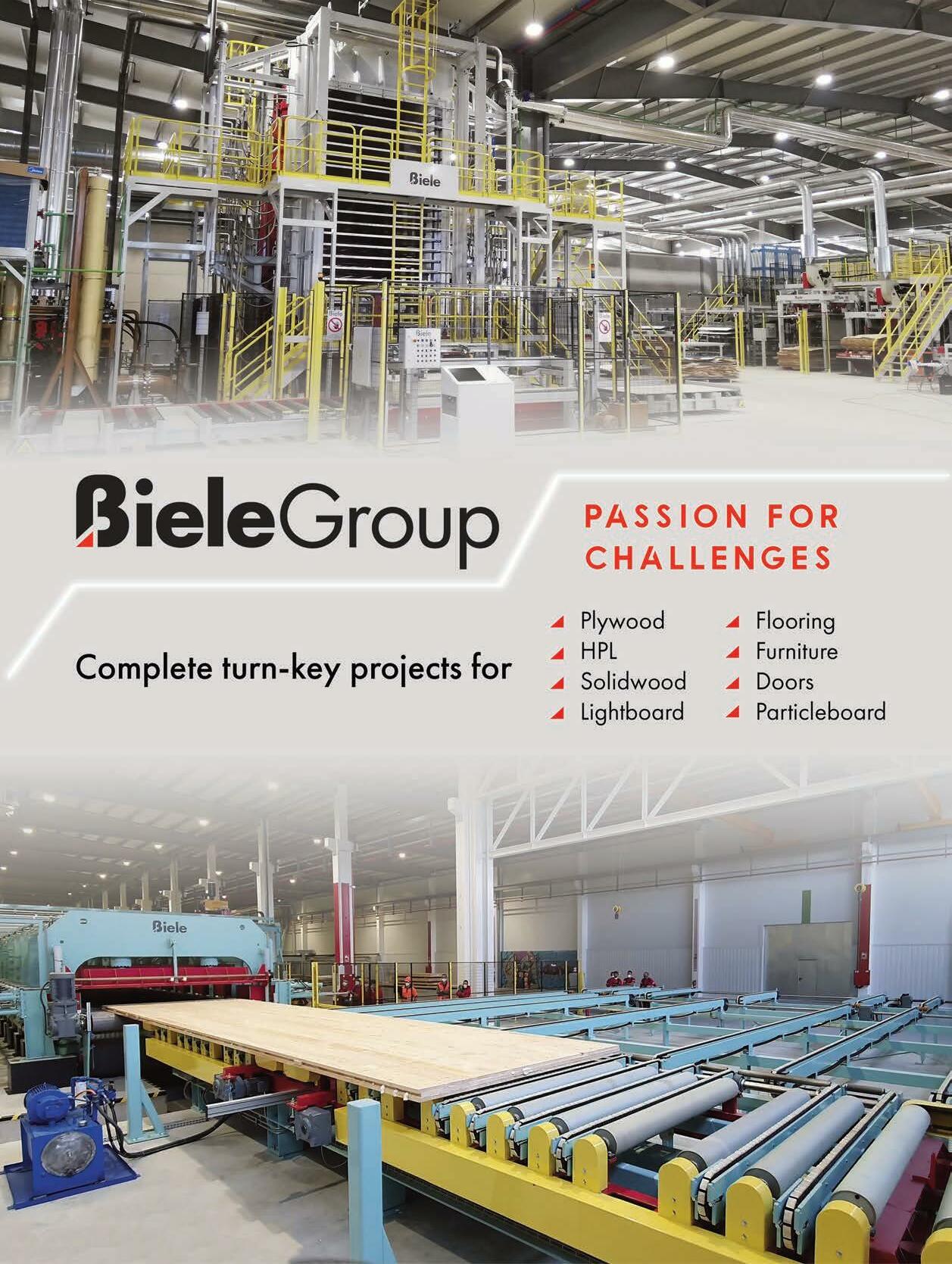
CLICK HERE IF YOU HAVE NOT ALREADY OPTED IN!

CLICK HERE IF YOU HAVE NOT ALREADY OPTED IN!
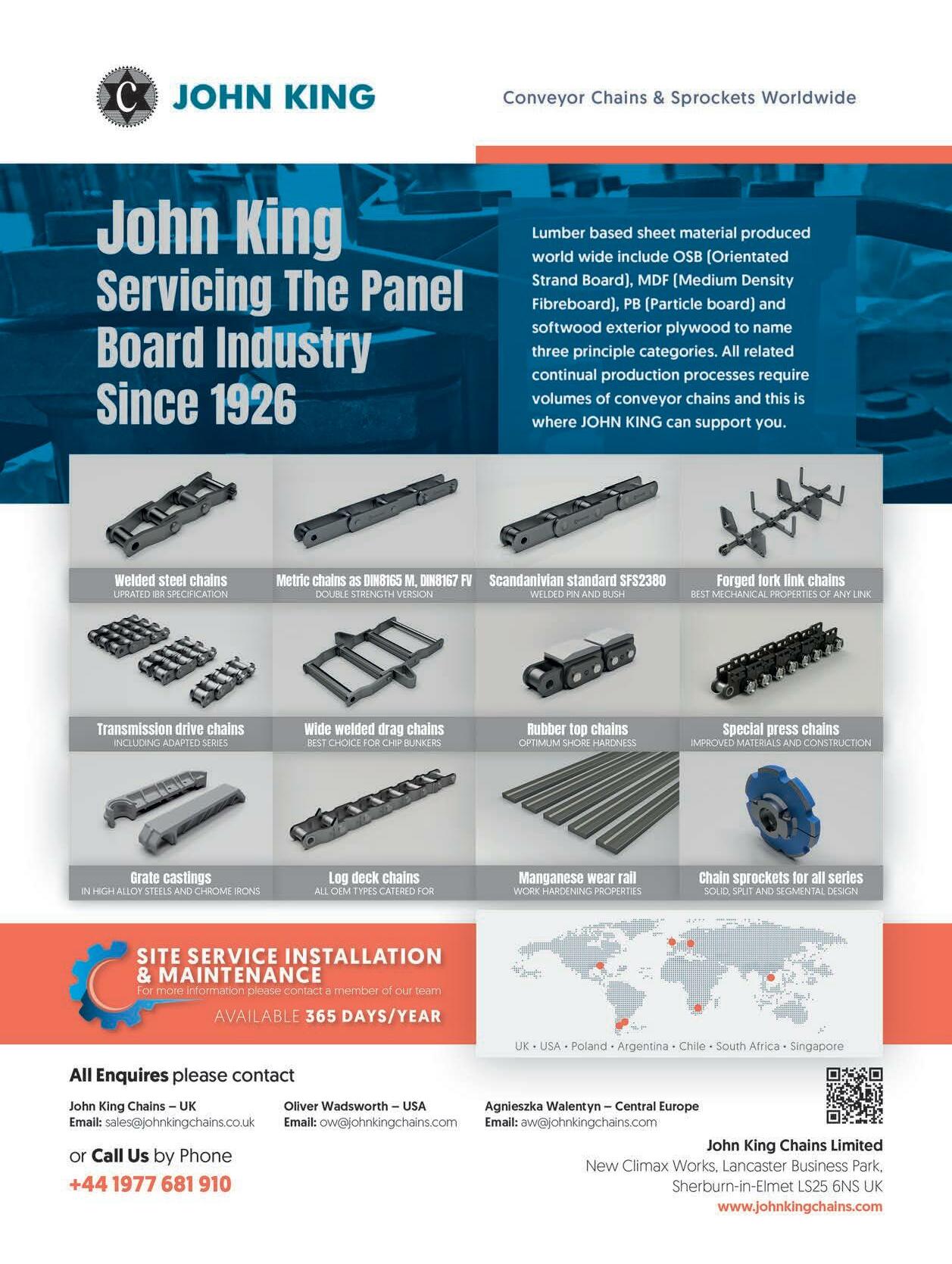
CLICK HERE IF YOU HAVE NOT ALREADY OPTED IN!
and availability. It will significantly improve board quality and expand our range of board formats and thicknesses, allowing us to enter the market for thin panels, a biocomposite in high demand in North America.”
PLYWOOD OPERATIONS
ORDER LAYUP LINES
Due to the industry-wide challenge to get labor, automation plays a big part in profitable production. This is one of the reasons Richmond Plywood Corp. Ltd. (Richply), Canada, and Tolko Industries Ltd., Canada, have invested in Raute Plywood Lay-up Line R7, and Swanson Group, USA, has ordered a Raute Plywood Lay-up Line R5. These new layup lines will replace existing labor-intensive lines.
With 50 deliveries of one-sided-gluing plywood layup lines, Raute is the global leader of this technology. These deliverable R7-Series and R5-Series plywood layup lines are semi-automated. Raute Lay-up Line R7 will run with two operators and the one-sided gluing operation will reduce the mill’s glue consumption. Raute Lay-up Line R5 will run with two operators using a roll coater and have a small footprint.

Lines are designed and manufactured jointly in Raute Canada and Raute Finland. Lines are expected to be delivered in 2023-2024.
TAFISA ENHANCES
DIGITAL INSPECTION
Tafisa, the largest particleboard manufacturer in North America, has looked again to Argos Solutions for state-of-theart grading systems at their production facility in Lac-Megantic, Quebec. This is the third digital surface inspection system the company has purchased from Argos, and the grading system will be used in the production of decorative panels.
“Our experience with Argos, their systems, the technology, and the support we received has been excellent,” says Remy Gosselin, production technician at Tafisa.
Tafisa needed a reliable grading system that was able to inspect every panel in the production process. In addition, the complexity of the panels and their decors required innovative and well-functioning technology.
“The performance the grading systems demonstrated in our other production lines was positive enough that we decided to add another grading system from

50 • NOVEMBER 2022 • PanelWorld 46 ➤ CLICK HERE IF YOU HAVE NOT ALREADY OPTED IN!

CLICK HERE IF YOU HAVE NOT ALREADY OPTED IN!
PROJECTS
Argos. The track record for grading EIR (Embossed In Register) surfaces, and Argos technology was important for us,” Gosselin says.
EIR is a technique used by manufacturers to enhance the appearance of real wood. This product is both challenging and time consuming to control for the human eye. The Argos technology precisely controls every panel produced allowing the manufacturer to quickly adjust the press and downgrade panels based on EIR deviations.
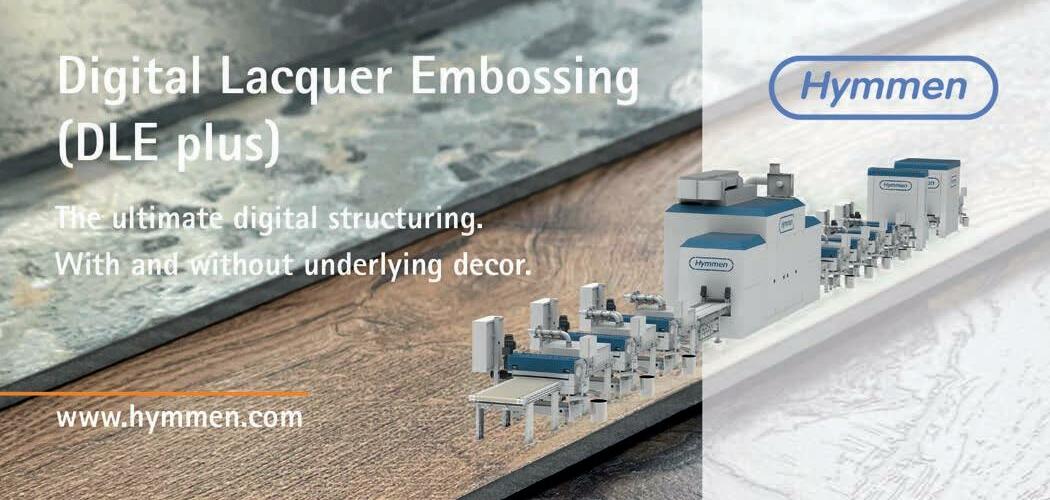
“For us, Tafisa is a highly valued cus-
tomer and partner, says Richard Lepine, Argos General Manager. “We appreciate the opportunity to continue to deliver solutions that will contribute to quality products and an even more smooth-running operation. These systems will provide added value, both for Tafisa and their customers.”
GREENLAM SOUTH ORDERS
PARTICLEBOARD PLANT
Greenlam South Ltd. has ordered a high-end particleboard plant from Dief-
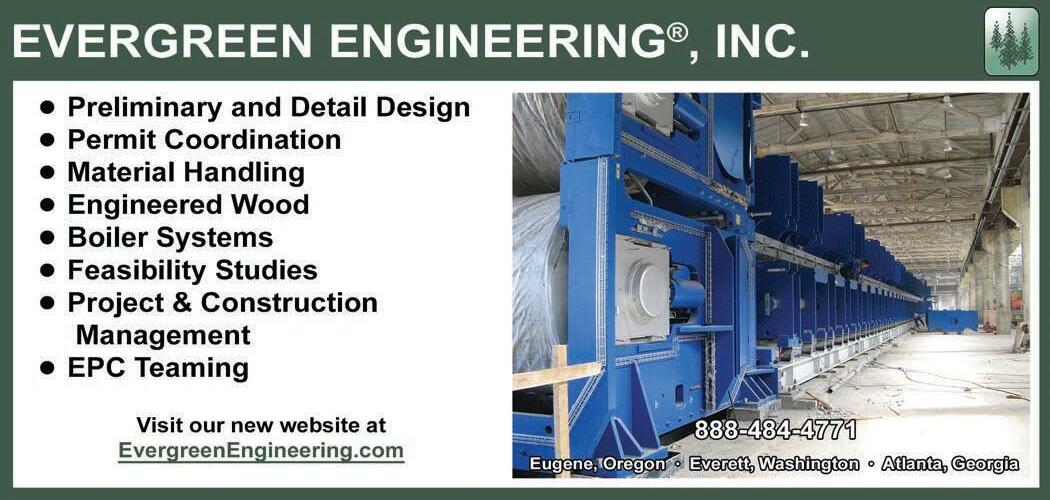
fenbacheer for its new manufacturing facility in Andhra Pradesh. Commercial production of up to 265,000 m³ of particleboard per year is expected by 2023-24.
With more than 5,000 employees and a production capacity of 15.62 million sheets of HPL per annum, Greenlam is among the world’s top three producers of laminates.
Saurabh Mittal, Managing Director & CEO at Greenlam Industries, says, “Our new Dieffenbacher particleboard plant marks our third production unit in India and puts us on a path to be-
52 • NOVEMBER 2022 • PanelWorld CLICK HERE IF YOU HAVE NOT ALREADY OPTED IN!
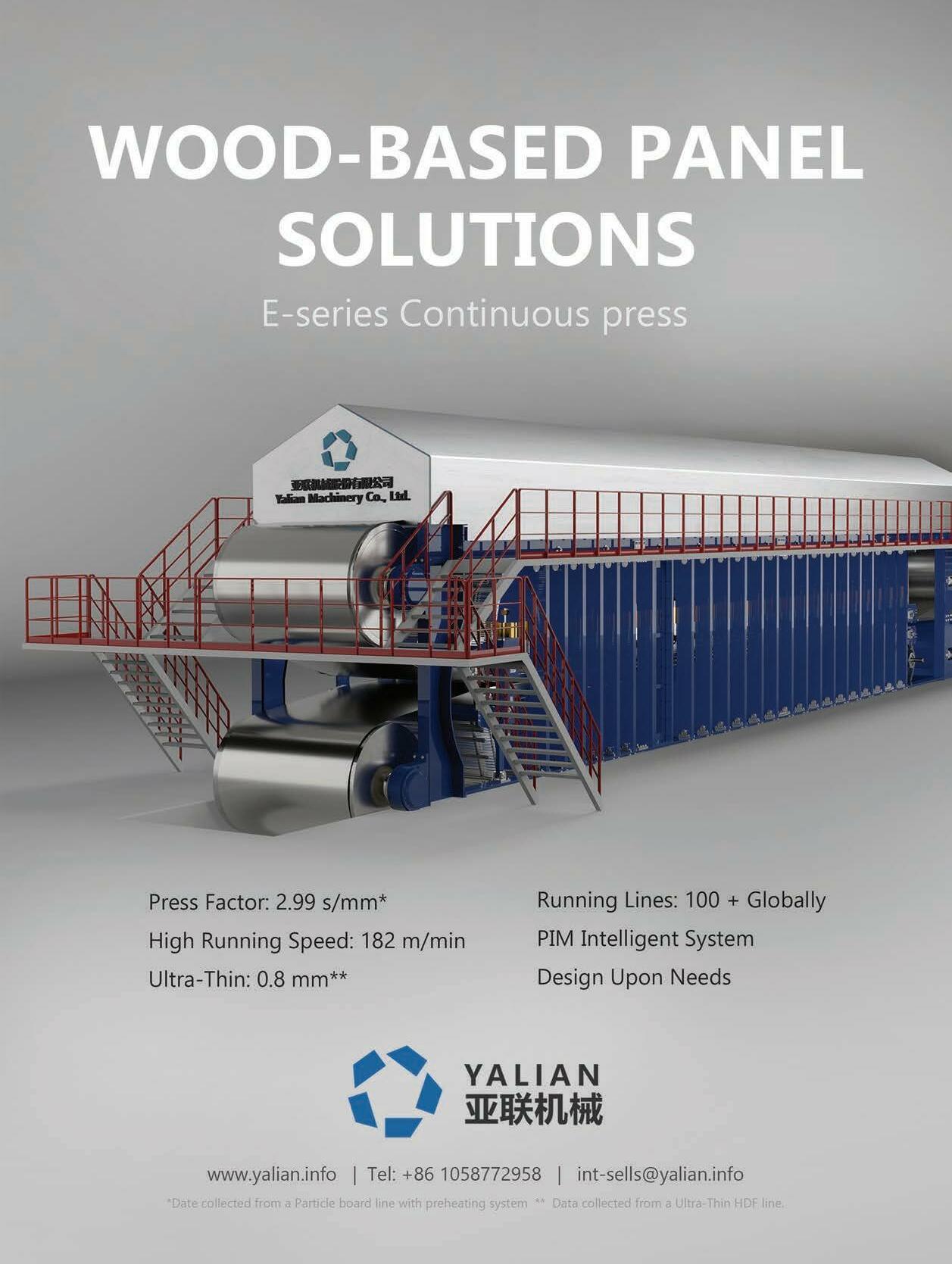
CLICK HERE IF YOU HAVE NOT ALREADY OPTED IN!
coming a leading wood-panel producer in India.” Greenlam has 15 international offices and four international distribution centers from which it exports products to more than 100 countries.
Dieffenbacher will supply the plant’s forming station and forming line with prepress, the CPS+ continuous press with press emission control system, the raw board handling system and the dryer. Also included are engineering, electrics and plant automation for the complete plant and the proven and highly flexible Lukki raw board storage system.
Greenlam’s new plant will feature EVORIS, Dieffenbacher new digital platform.
LP, BIELE COLLABORATE ON NEW SHAKE LINE
Louisiana-Pacific and Biele Group have successfully implemented their first project consisting of a shake profile production line in Swan Valley, Manitoba, Can. LP’s investment is part of their expansion plans for siding products in the
building market within their LP SmartSide Trim & Siding brand.
The project consists of a fully automatic shake profile production line that is fed with 8x4 ft. OSB panels for several postprocessing processes to get different sized shakes. The Biele line feeds the mother board and cuts into multiple pieces that will be profiled, painted and packaged according to different recipes.
According to LP Engineering Project Manager Danaillie Woodfine, “Prior to adding the shake line in Swan Valley, LP had a shake line in Roaring River, North Carolina. Customer demand for the shake product was outpacing the capacity of the Roaring River line. The new shake line includes more automation and an increased line speed that is capable of twice the production of the Roaring River line. This increase capacity will allow LP to meet future customer demand.”
Danaillie also points out that “working with Biele exceeded my expectations. The team went above and beyond to ensure we received a quality product. Doing business during COVID-19 was often

times unpredictable, but Biele was able to adapt quickly to changes in order to keep the project on track. I would definitely recommend Biele for future projects.”
STARWOOD EXPANDS PRODUCTION CAPACITY
On June 28 Starwood successfully produced the first board on its Siempelkamp thin board plant for MDF at the Inegöl, Turkey location. After a ramp-up curve, stable three-shift operation has also been achieved.
A total of three Siempelkamp ContiRoll continuous press plants now produce MDF, L-MDF, and thin board in Inegöl. The total output of these three plants will allow a capacity of more than 2,500 to 3,000 m³/day.

54 • NOVEMBER 2022 • PanelWorld PROJECTS CLICK HERE IF YOU HAVE NOT ALREADY OPTED IN!
IWF WOWS ’EM IN ATLANTA


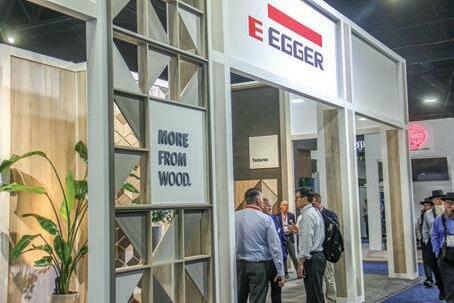
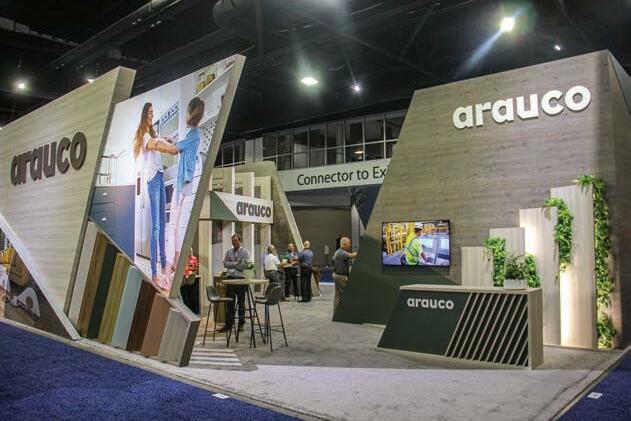
More than
in the

lanta,
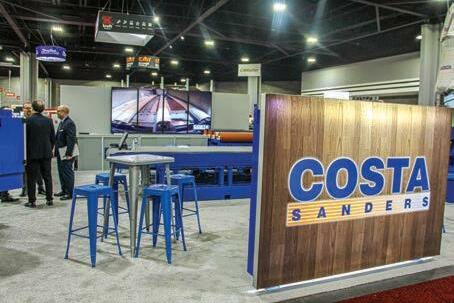

PanelWorld • NOVEMBER 2022 • 55 IWF
900 exhibitors presented machinery, services and supplies at the International Woodworking Fair (IWF) held August 23-26
Georgia World Congress Center in At-
Ga. The exhibitor space comprised 1.2 million square feet. One of the unique aspects of IWF is the blend of machinery company exhibits and wood products producer displays, as shown
in these photos. (Photos by Rich Donnell and David Abbott).
CLICK HERE IF YOU HAVE NOT ALREADY OPTED IN!
SIEMPELKAMP
NEW LEADERSHIP
Beginning in 2023, Martin Scherrer becomes a member of the management board of the Siempelkamp Group and will succeed Dr. Martin Stark as CEO of the management board in July 2023. In October 2022, Martin Sieringhaus became the new CFO of the Siempelkamp Group, succeeding longstand-

ing commercial managing director Elisabeth Bienbeck-Ketelhohn, who is retiring in March 2023.
Scherrer joins Siempelkamp from AstenJohnson, a supplier to the paper industry, where he recently headed the business as President Eurasia.
“We are pleased that we were able to win Martin Scherrer and Martin Sieringhaus, two internationally very experienced and successful managers in plant engineering and service, for the Siempelkamp Group. Mr. Scherrer provides extensive experience in strategic development and the implementation of change processes. Mr. Sieringhaus also managed the commercial aspects of extensive change initiatives,” says Bertram Staudenmaier, Chairman of the Siempelkamp Advisory Board.
WMF 2022 COVERS ENTIRE SUPPLY CHAIN
Shanghai International Furniture Machinery & Woodworking Machinery Fair (WMF), together with China International Furniture Fair (CIFF Shanghai) and China International Building Decoration Fair (CBD Shanghai), came to a close on September 8, attracting more than 61,000 buyers. The three fairs showcased 1,200 exhibitors using 280,000 square meters of space. WMF had a 45,000 square meters exhibition area with 300+ exhibitors, which gathered leading enterprises in various segments of home furnishing and woodworking manufacturers in four days.
WMF is committed to integrating industry resources upstream and downstream of the whole woodworking supply chain.
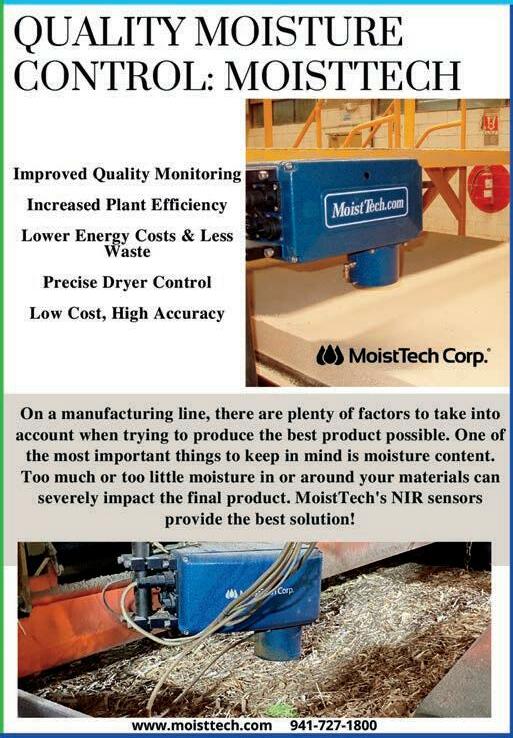
WMF2023 will take place September 5-8, 2023 at the National Exhibition and Convention Center, Shanghai Hongqiao.
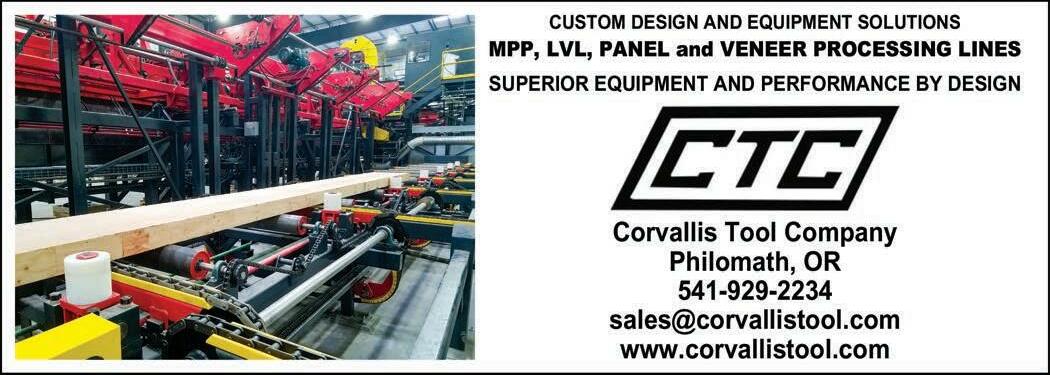
56 • NOVEMBER 2022 • PanelWorld
NAMES
LINES SUPPLY
New dual leadership for Siempelkamp: Martin Scherrer, left, and Martin Sieringhaus
CLICK HERE IF YOU HAVE NOT ALREADY OPTED IN!



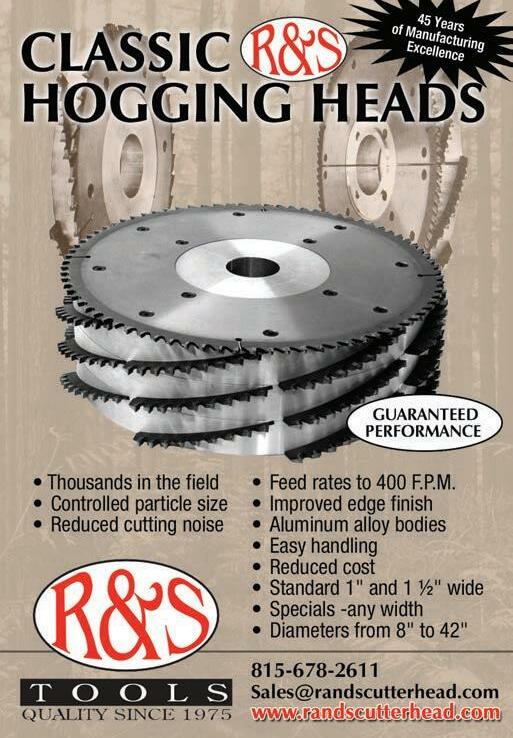
CLICK HERE IF YOU HAVE NOT ALREADY OPTED IN!
l Experienced and knowledgeable leadership.
l Safe and environmentally responsible.
l Ready acceptance of new technology and ideas.
l Plans for, achieves, and maintains sustainability.
l Employee involvement and collaboration.
l Reliable, trustworthy, and predictable leadership.
6. ASSESS RESULTS AND MAKE ADJUSTMENTS
Few can imagine attending a sporting event without a scoreboard. Similarly, successful mills measure results and compare those measurements to goals. Monitoring performance is crucial to creating a Flow experience for employees.
Theoretical academics and practical businessmen agree that accurate measurement is invaluable. In subatomic physics, the observer effect is the change of an observed system by the mere existence of observation. Thomas Monson, then CEO of the media company Deseret News, stated, “When performance is measured, performance improves. When performance is measured and reported back, the rate of improvement accelerates.”
Data is “boiled-down” into a “vital few of the many” statistics that become timely communication tools for all within the workgroup. The chosen statistics best compare actual results to the performance goals. As a common language, these statistics become essential to achieving employee involvement.
Key performance metrics for veneer-based producers often include:

l Safety Statistics. Mostly based on OSHA definitions.
l Log Conversion Efficiency. Often net veneer produced per unit of raw material.
l Lathe Efficiency. Normally blocks processed and green veneer production per hour.
l Labor Efficiency. Paid manhours relative to sales volume.
l Downtime. Typical percentage of non-productive time per operating hour.
l Production. Usually expressed as production volume per hour.
CONCLUSIONS
Bill Lee, founder of a business consultancy that focuses on building materials dealers, wisely cautioned, “One result of a “Blowout” economy is the tendency for owners and managers to pay less attention to profit planning than in the years when the business must scratch hard to generate sales, control gross margin, and manage operating expenses.” (Lee, Bill. “Profit Planning Wisdom.” LBM Journal. Oct. 2022.)
Extraordinary pandemic prices allowed veneer-based producers to generate record profits, in spite of the staffing shortages. As the market cools and high prices no longer hide all problems, finding a committed core of long-term employees is a hidden opportunity.
While these six action steps are not exhaustive or a cure-all, they represent a structured thinking process. The steps will contribute to improved decision-making, cost control, and profitability in addition to improving hiring and retention. Together with smart capital improvements and meeting unique customer needs, better staffing strategies can become a business strength instead of holding back the business.
PW
Richard (Dick) Baldwin is managing partner of Oak Creek Investments and a lifelong participant in the veneer and plywood production industry. Rich Baldwin is CFO-Treasurer of Oak Creek Investments with substantial consulting and proposal experience in wood products operations.
18 ➤ 58 • NOVEMBER 2022 • PanelWorld CLICK HERE IF YOU HAVE NOT ALREADY OPTED IN!
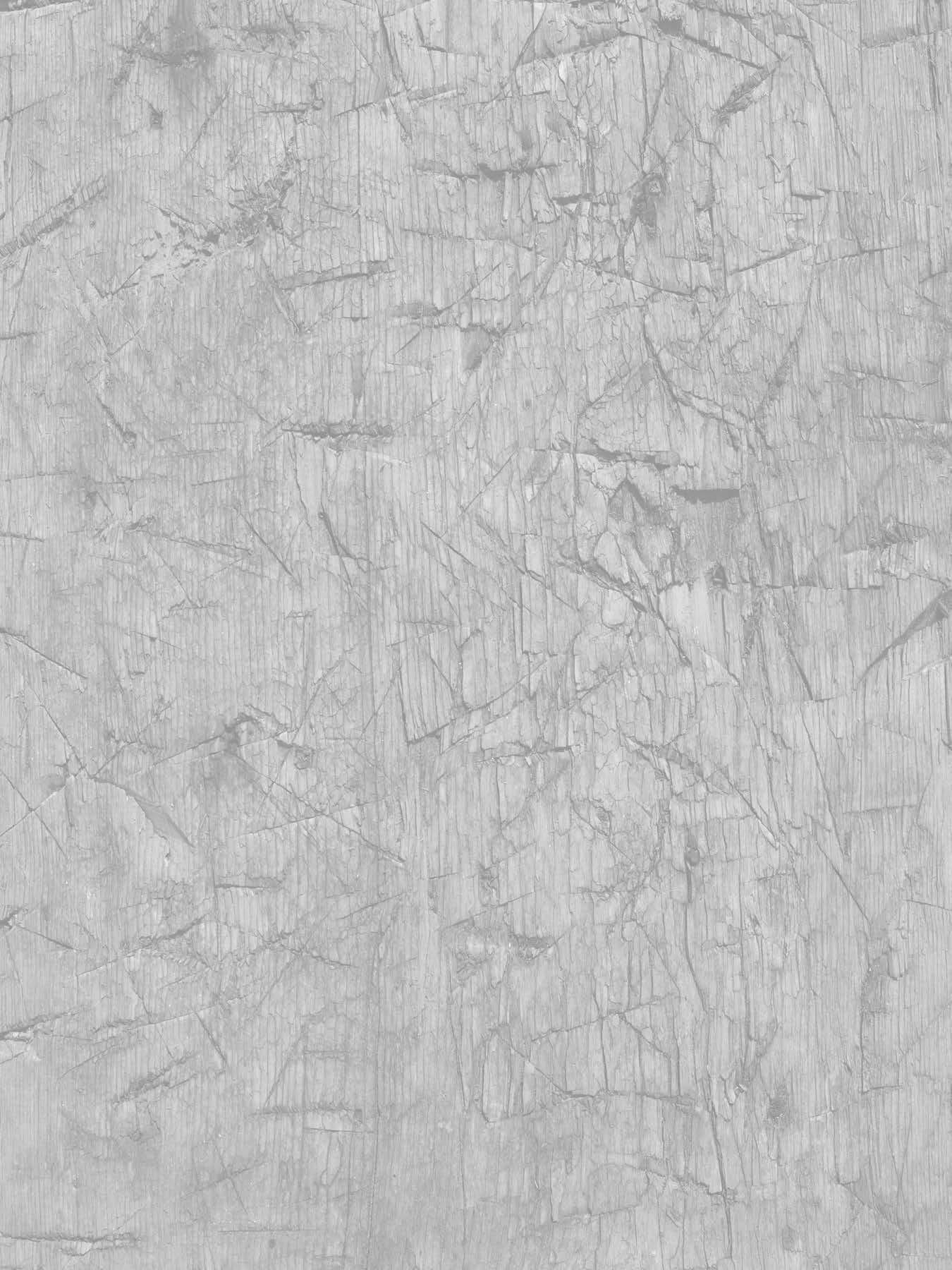


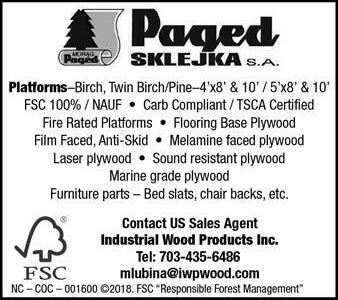



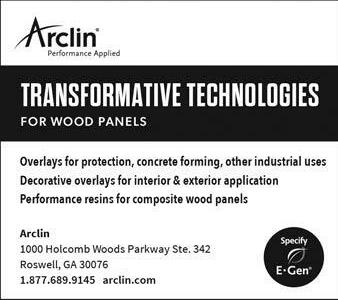

11/22 VENEER/PANEL SUPPLIERS DIRECTORY SPECIALISTS IN AUSTRALIAN & PACIFIC VENEERS FSC & PEFC ECO-CERT Veneers from around the world Over 150 species in stock Reconstituted veneer/spliced faces/rotary veneers Website:www.briggs.com.au Email:admin@briggs.com.au Tel: +61 2 9732-7888 AUSTRALIA/OCEANIA www.fsc.org ■ Poland ■ Switzerland Producers of high quality fine face veneers. Specializing in species indigenous to the West Coast. We manufacture Music grade solids and veneers. We also offer custom slicing, cut-to-size and log breakdown. Fir • Hemlock • Spruce • Pacific Maple (Figured and Plain) • Alder Western Red Cedar 6670 - 144th Street, Surrey, BC V3W 5R5 Plant: (604) 572-8968 Fax: (604) 572-6608 NORTH AMERICA ■ Canada ■ British Columbia ■ Ontario A FULL SERVICE PLYWOOD & VENEER COMPANY WE OFFER: Short turnaround time, In-house veneer mill—ROTARY, FLAT CUT, RIFT and QUARTERS, Custom pressing capabilities, Architectural specified plywood jobs, Huge veneer and core inventory, Over 100 natural species and engineer veneers in stock, All sizes and thicknesses–6'x4' to 5'x12', Internal logistics for fast on-time deliveries Contact us: Birchland Plywood-Veneer Ltd. TeL: 705-842-2430 • Fax: 705-842-2496 Visit www.birchlandplywood.com to view our “Live Log Program” EUROPE 113 Years Experience In Wood Reserve your space today. Call Melissa McKenzie 800-669-5613 ■ United States ■ Georgia ■ Indiana Amos-Hill Associates, Inc. Quality Veneers Manufacturers of Decorative Hardwood Veneer Domestic and International Markets Species include: Walnut, White Oak, Red Oak, Hard Maple, Cherry and Birch “Quality is the Lifeblood of our Business” 112 Shelby Ave. ◆ P.O. Box 7 Edinburgh, IN 46124 Phone: 812-526-2671 ◆ Fax: 812-526-5865 E-mail: info@amoshill.com Website: www.amoshill.com The mark of responsible forestry FSC Supplier: SCS-COC-002445 * SCS-CW-002445 CLICK HERE IF YOU HAVE NOT ALREADY OPTED IN!
a
of
send via email, and we will typeset it for you for
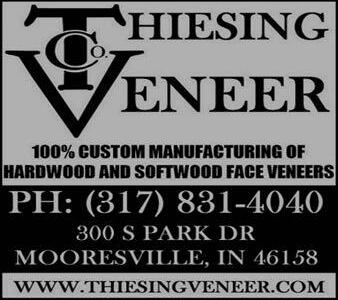
be sure to include appropriate contact information so we may contact you for questions and payment.
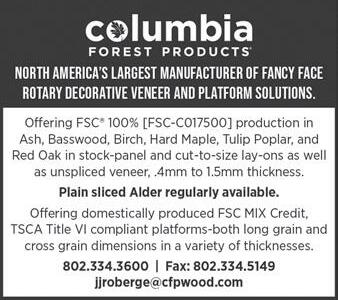


sure to send any artwork that should be included in your ad. It should be a good-quality print or high resolution logo. We will fax or email you a proof before final print for your approval.





11/22 VENEER/PANEL SUPPLIERS DIRECTORY NORSTAM VENEERS, INC. MANUFACTURER OF QUALITY HARDWOOD AND SOFTWOOD VENEERS Kiln Dried Thick Backing Boards P.O. BOX 32 HWY. 135 BUS: 812.732.4391 MAUCKPORT, IN 47142 FAX: 812.732.4803 EMAIL: info@norstam.com Proud to announce we have the “Newest Veneer Mill in the World” ■ Mississippi ■ Michigan ■ Ohio ■ Pennsylvania ■ Vermont Proudly serving our clients in the hardwood plywood sheetstock, plywood component, solid wood component, face and core veneer markets for over 40 years. Looking forward to applying our worldwide knowledge and resources to help create the solution you need. inquiry@pittsburghforest.com Office: 724.969.5000 375 Valleybrook Rd, McMurray, PA 15367 ESTABLISHED 1972 Reserve your space today. Call Melissa McKenzie 800-669-5613 VENEER/PANEL SUPPLIERS DIRECTORY NEXT CLOSING: MARCH 23, 2023 Send your ad information on
separate sheet
paper, or
FREE. Please
Make
Send ad info to: VENEER/PANEL SUPPLIERS DIRECTORY PO Box 2268 Montgomery, AL 36102-2268 or send ad to: melissa@hattonbrown.com CLICK HERE IF YOU HAVE NOT ALREADY OPTED IN!

CLICK HERE IF YOU HAVE NOT ALREADY OPTED IN!
Altec Integrated Solutions 5 604.529.1991
46 800.526.1072
Biele Group 47 +34 629 429 620
Buttner GmbH 64 +49 2151 448 844
Carl KRAFFT & Söhne Gmgh 10 +49 2421 9360 0
Claussen All-Mark International 57 800.252.2736
Corvallis Tool 56 541.929.2234
Custom Engineering 17 814.898.2800
Daubert Chemical 29 844.243.0855
Dieffenbacher GmbH 7 +49 0 7262 65 103
Dunhua Bytter Technology 11 +86 158 3494 0870
Dürr Systems 25 920.336.5715
Engineered Wood Technology Assn
Evergreen Engineering
Fagus GreCon
Grenzebach Maschinenbau GmbH
Hashimoto Denki
Hexion
Hymmen GmbH
Imal S.R.L
IPCO
Itipack Systems
John
Machinery
Mid-South
Pagnoni
253.620.7237
888.484.4771
704.912.0000
770.253.4980
281.741.0410
888.443.9466
+49 521 5806 516
+39 059 465 500
+46 26 26 56 00
866.999.3695
1977 681 910
+386 2 61300
562 47 2211
941.727.1800
62 • NOVEMBER 2022 • PanelWorld EVENTS 2-5 • Delhiwood 2023, India Expo Centre & Mart, Greater Noida, India. Call+91-80-4250 5000; visit delhi-wood.com. 29-31 • International Wood Products Assn. 67th World of Wood Convention, Hyatt Regency, Savannah, Ga. Call 703-8206696; visit iwpawood.org. 11-13 • American Forest Resource Council annual meeting, Skamania Lodge, Stevenson, Wash. Call 503-222-9505; visit amforest.org. 15-19 • Ligna: World Fair For The Forestry And Wood Industries, Hannover Exhibition Grounds, Hannover, Germany. Call +49 511 89-0; fax +49 511 89-32626; visit ligna.de. 25-28 • AWFS Fair 2023, Las Vegas Convention Center, Las Vegas, NV. Call 800-946-2937; visit awfsfair.org. 23-25 • Forest Products Machinery & Equipment Expo, Music City Center, Nashville, Tenn. Call 504-443-4464; visit sfpaexpo.com. 5-8 • WMF: Shanghai International Furniture Machinery & Woodworking Machinery Fair, National Exhibition and Convention Center, Shanghai, China. Call (852) 2516 3518; visit woodworkfair.com. 14-17 • APA-Engineered Wood Assn. Annual Meeting and Engineered Wood Technology Assn. Info Fair, JW Marriott Desert Spring Resort & Spa, Palm Desert, CA. Call 253-5656600; visit apawood.org and engineeredwood.org. Listings are submitted months in advance. Always verify dates and locations with contacts prior to making plans to attend. A ● D ● L ● I ● N ● K ADLINK is a free service for advertisers and readers. The publisher assumes no liability for errors or omissions.
BASF
6
52
45
36
41
63
52
15
19
38
King Chains 49 +44
Ledinek Engineering 21, 48
51 Meinan
Works 27 +81
Engineering 57 501.321.2276 MoistTech 56
Impianti SRL 50 +39 039 2352 1 Pal S.R.L 15 +39 0422 852 300 R & S Cutterhead Manufacturing 57 815.678.2611 Roo Glue 44 877.766.4583 Samuel Coding & Labeling Group 8 800.667.1264 Samuel Packaging Systems Group 37 800.323.4424 Sherdil Precision 23 519.727.4010 Signode 16 800.323.2464 Stela Laxhuber GmbH 58 +49 8724 899 0 Sweed Machinery 18 800.888.1352 Taihei Machinery Works 39 +81 568 73 6421 The Union Tool 33 574.267.3211 USNR 9 800.289.8767 WEKO Weitmann & Konrad GmbH 50 +49 711 7988 0 Wemhoner Surface Technologies 54 +49 5221 7702 0 Westmill Industries 2 877.607.7010 Woodmac Industries 51 +91 9888948355 Yalian Machinery 53 +86 0433 6346788 ZST 57 +8613911163711 This issue of Panel World is brought to you in part by the following companies, which will gladly supply additional information about their products. ADVERTISER PG.NO. PH.NO. MAY 2023 APRIL 2023 MARCH 2023 JULY 2023 SEPTEMBER 2023 AUGUST 2023 panelworldmag.com OCTOBER 2023 CLICK HERE IF YOU HAVE NOT ALREADY OPTED IN!
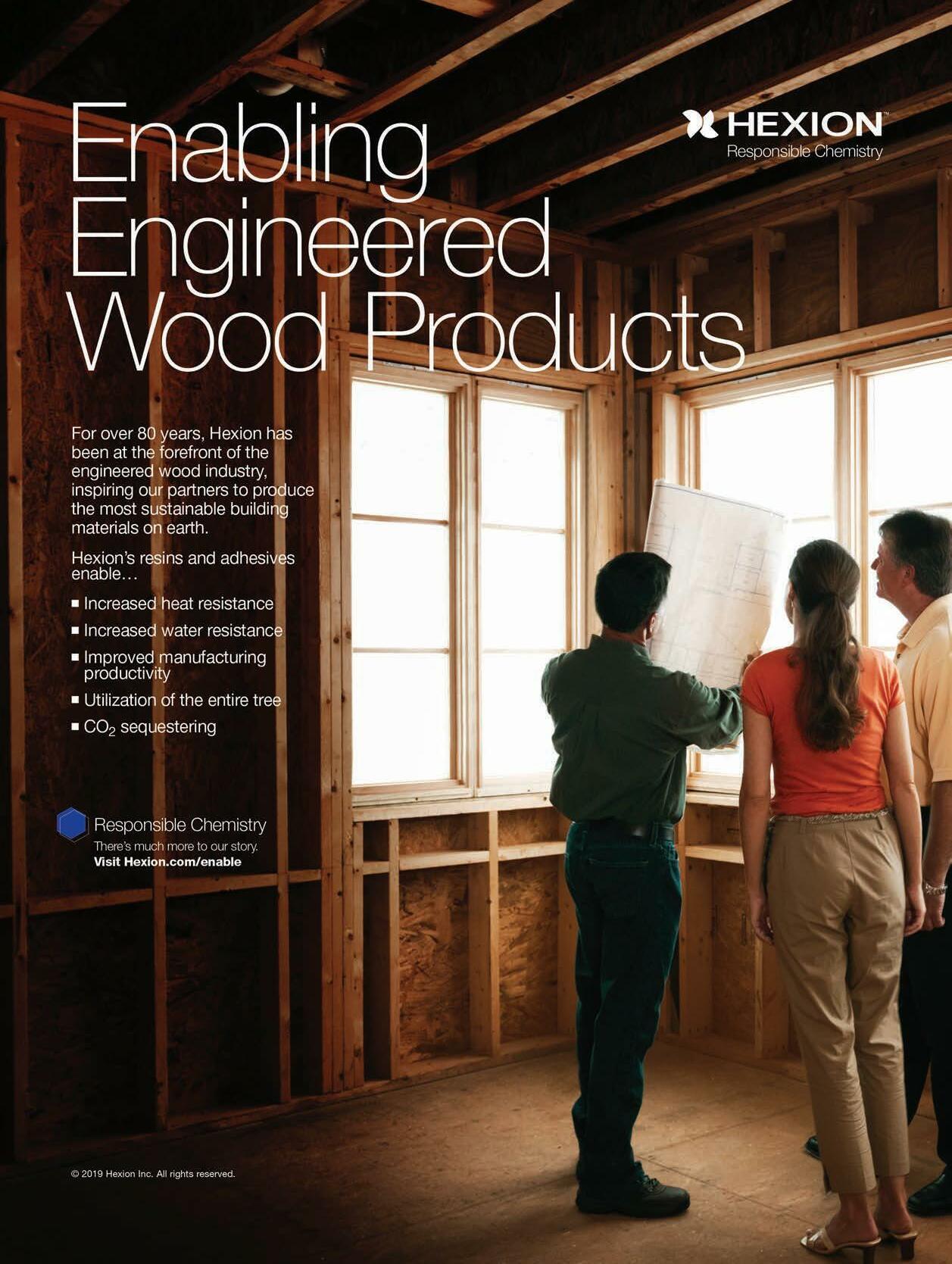
CLICK HERE IF YOU HAVE NOT ALREADY OPTED IN!

CLICK HERE IF YOU HAVE NOT ALREADY OPTED IN!







 Member, Verified Audit Circulation Managed By Hatton-Brown Publishers, Inc.
Member, Verified Audit Circulation Managed By Hatton-Brown Publishers, Inc.










































































































